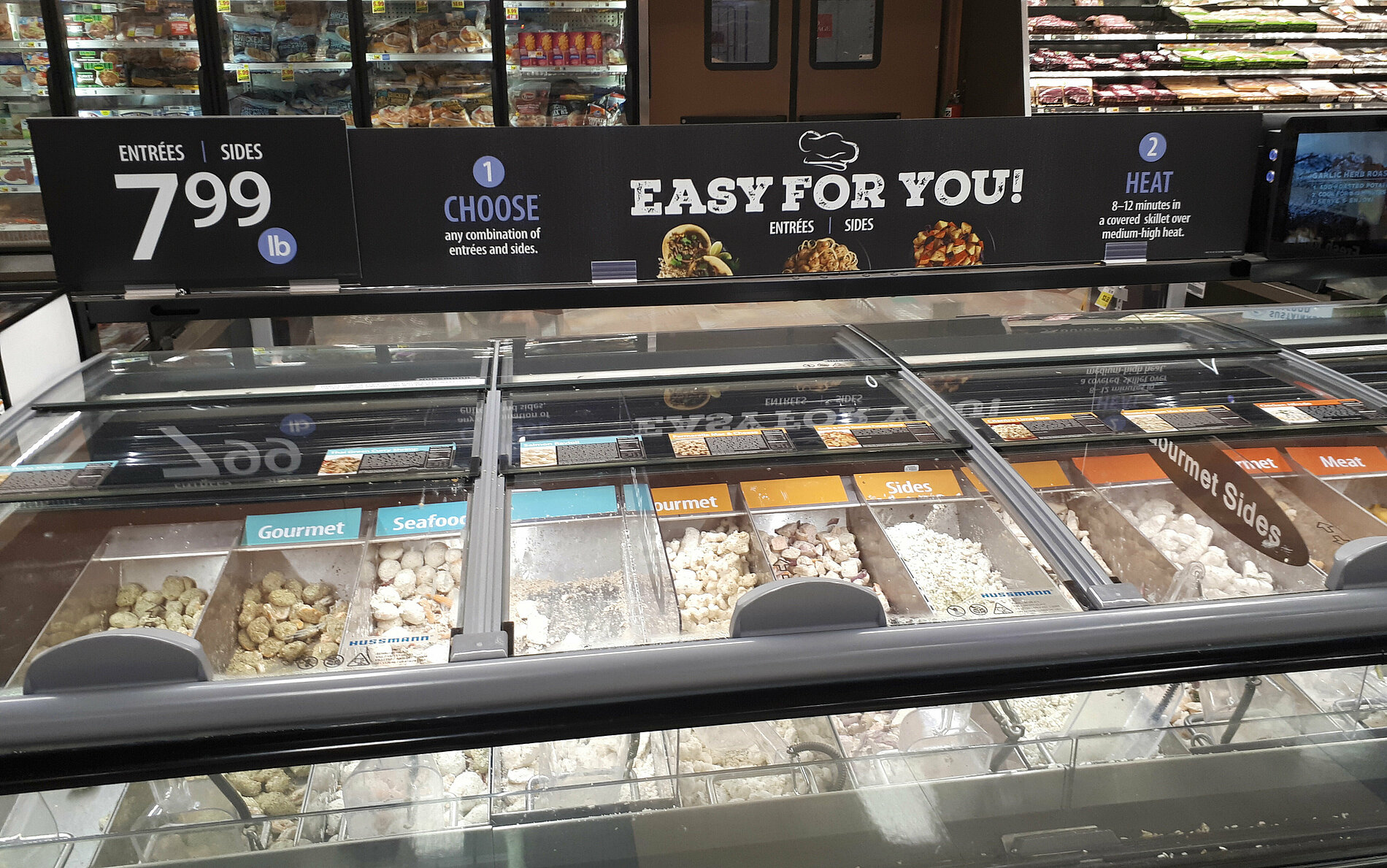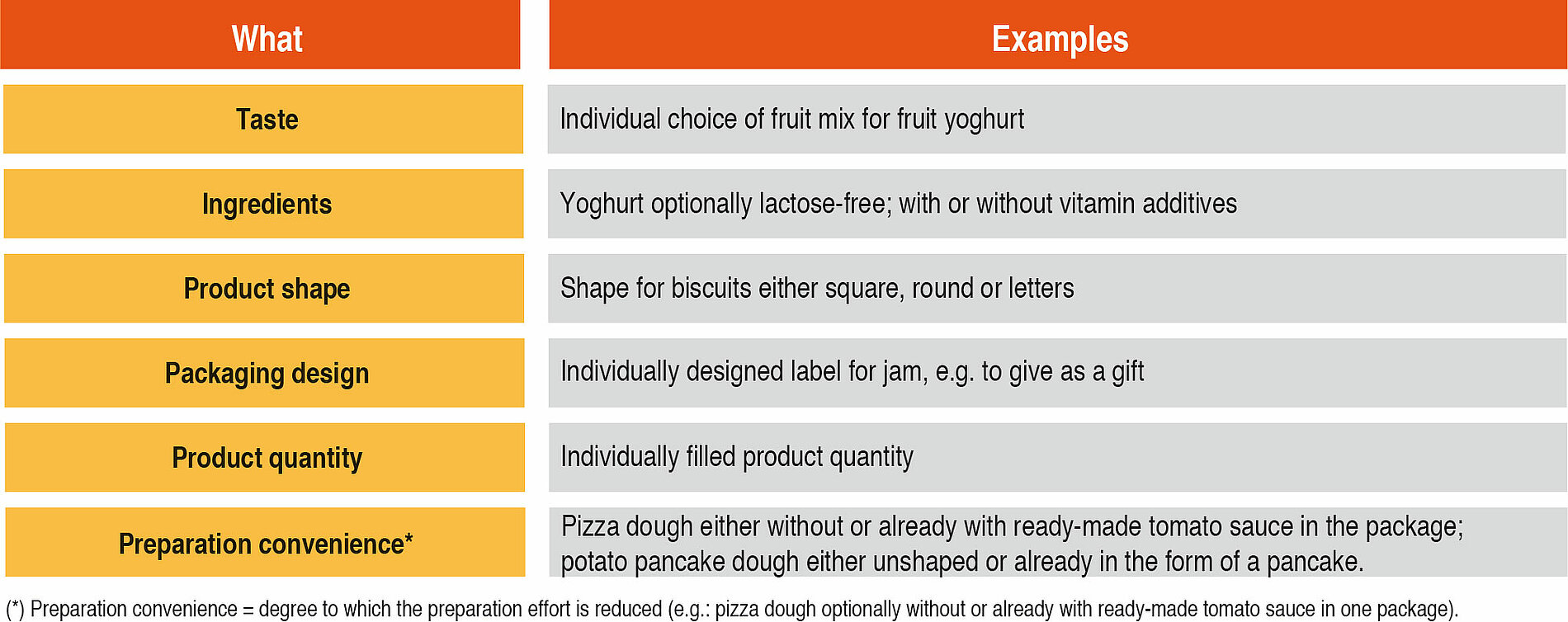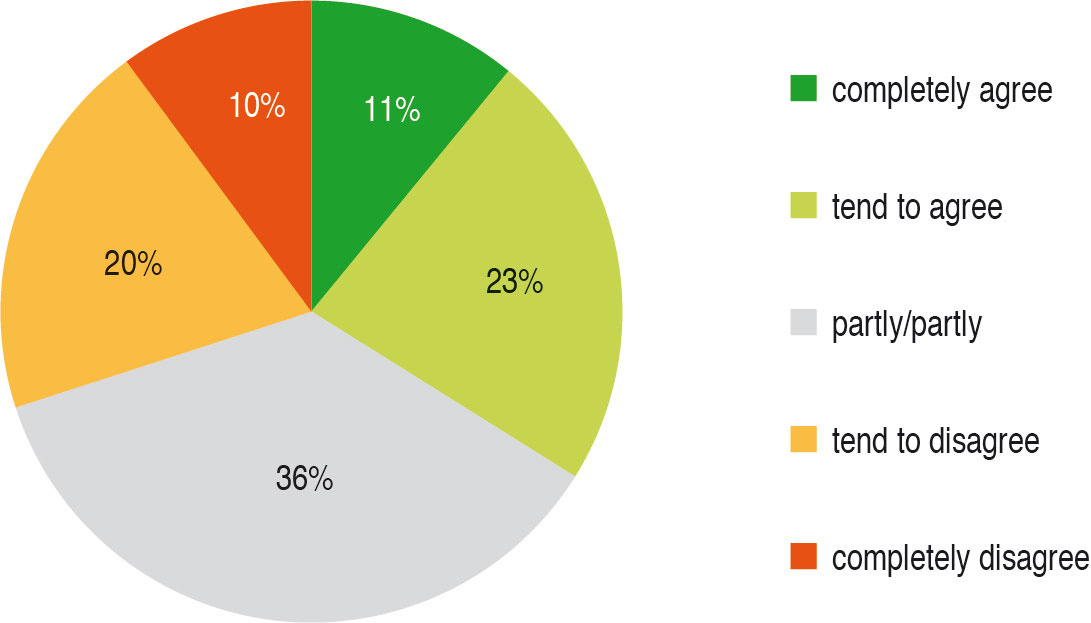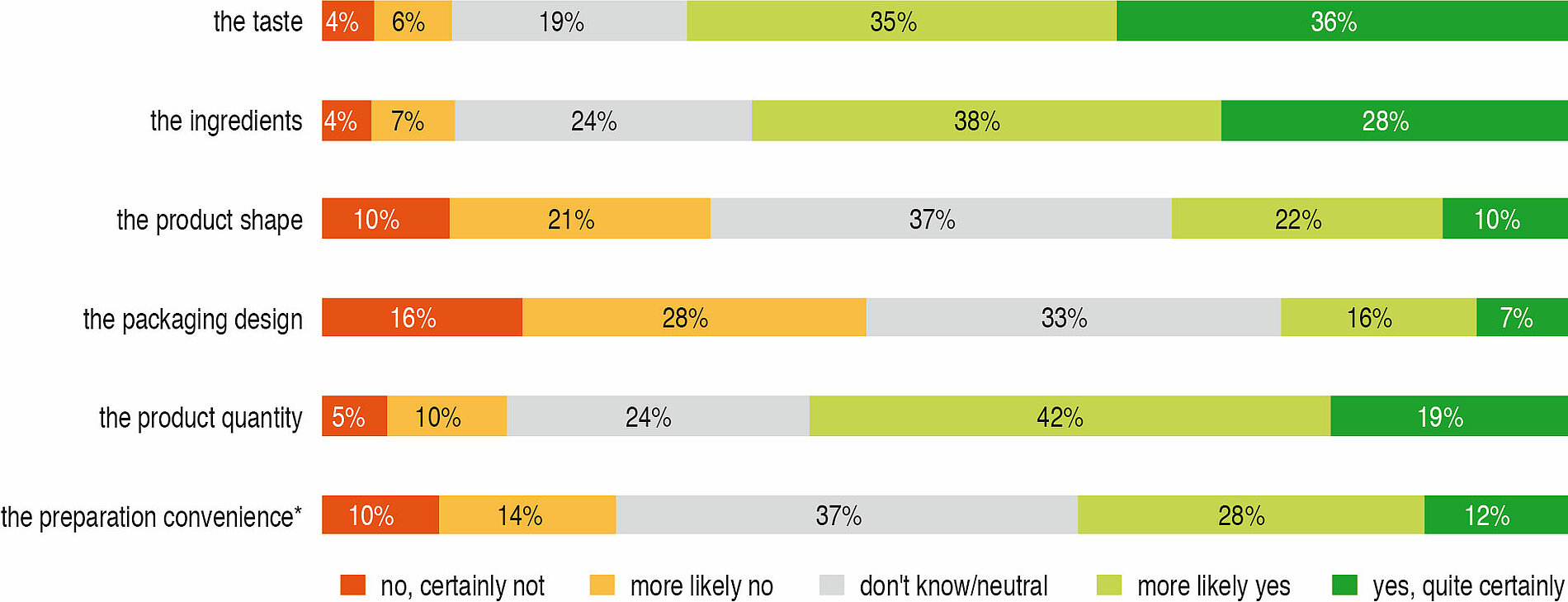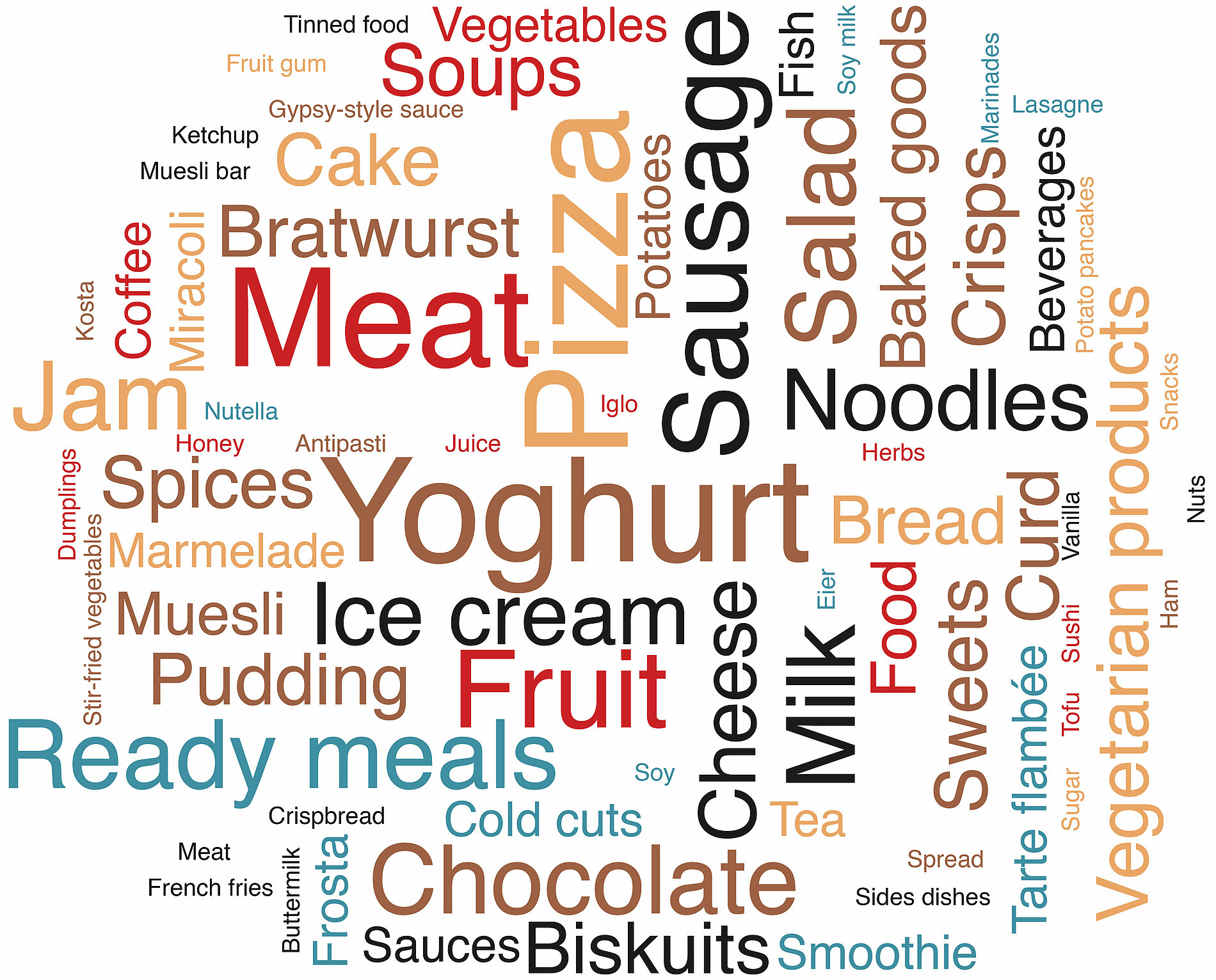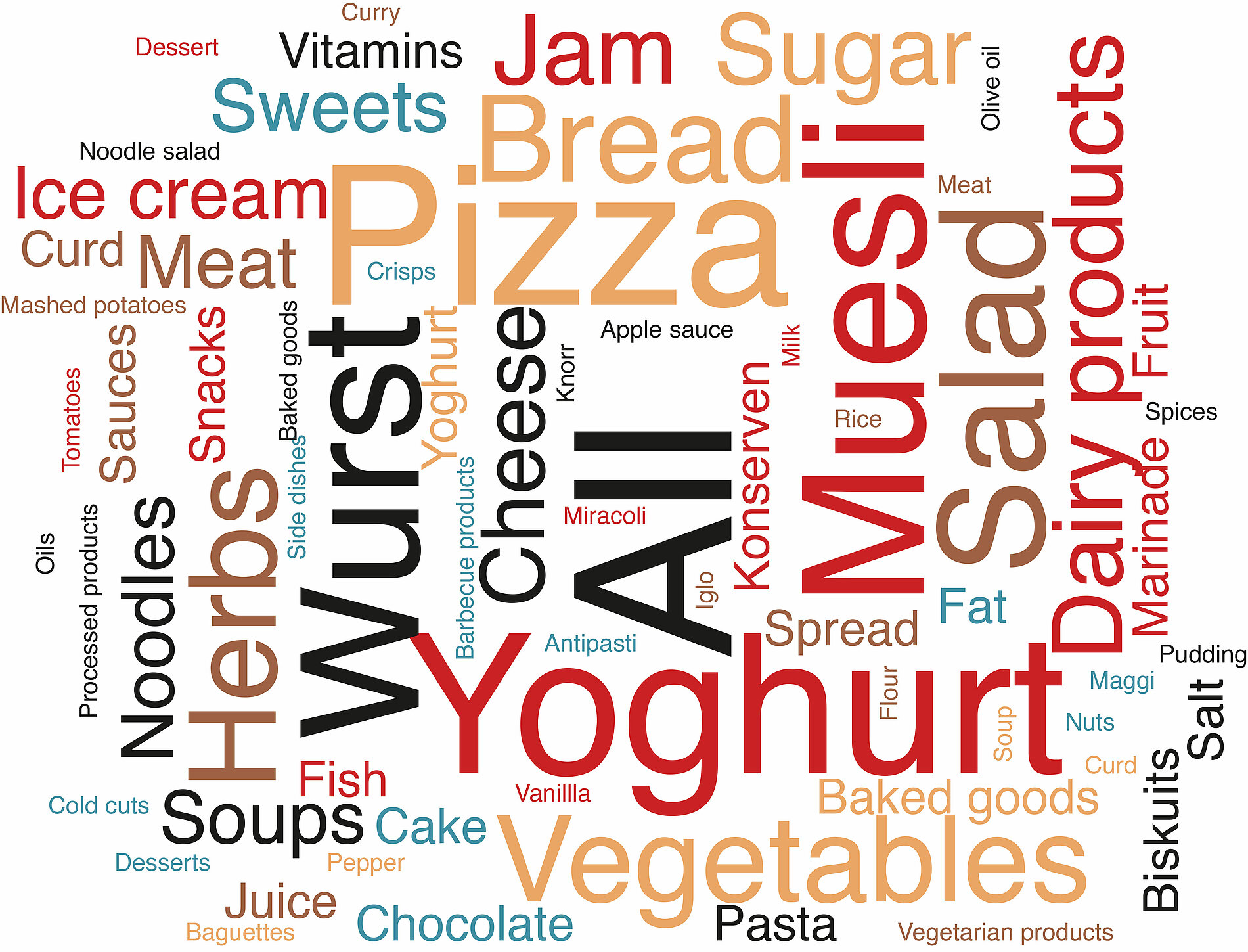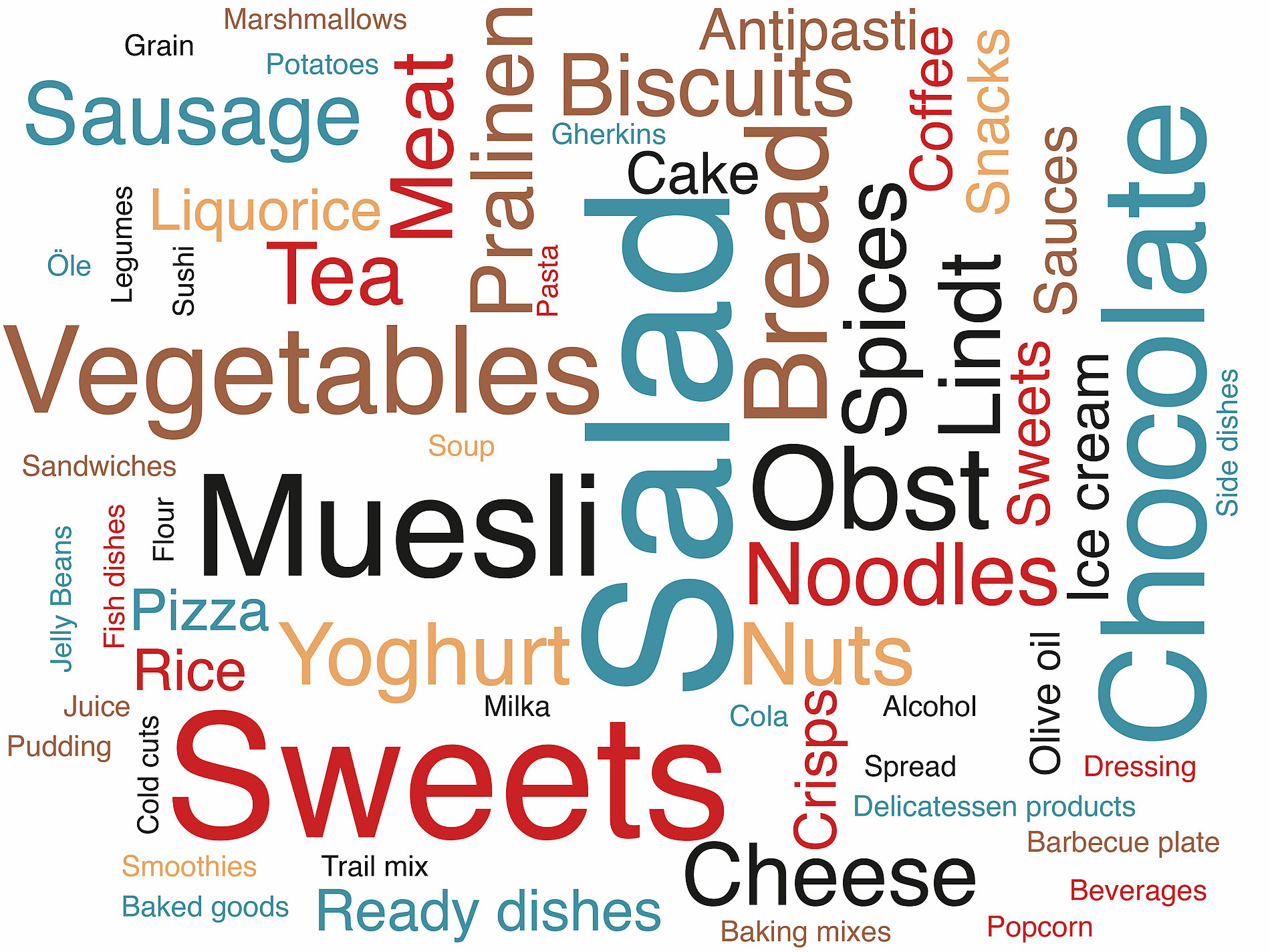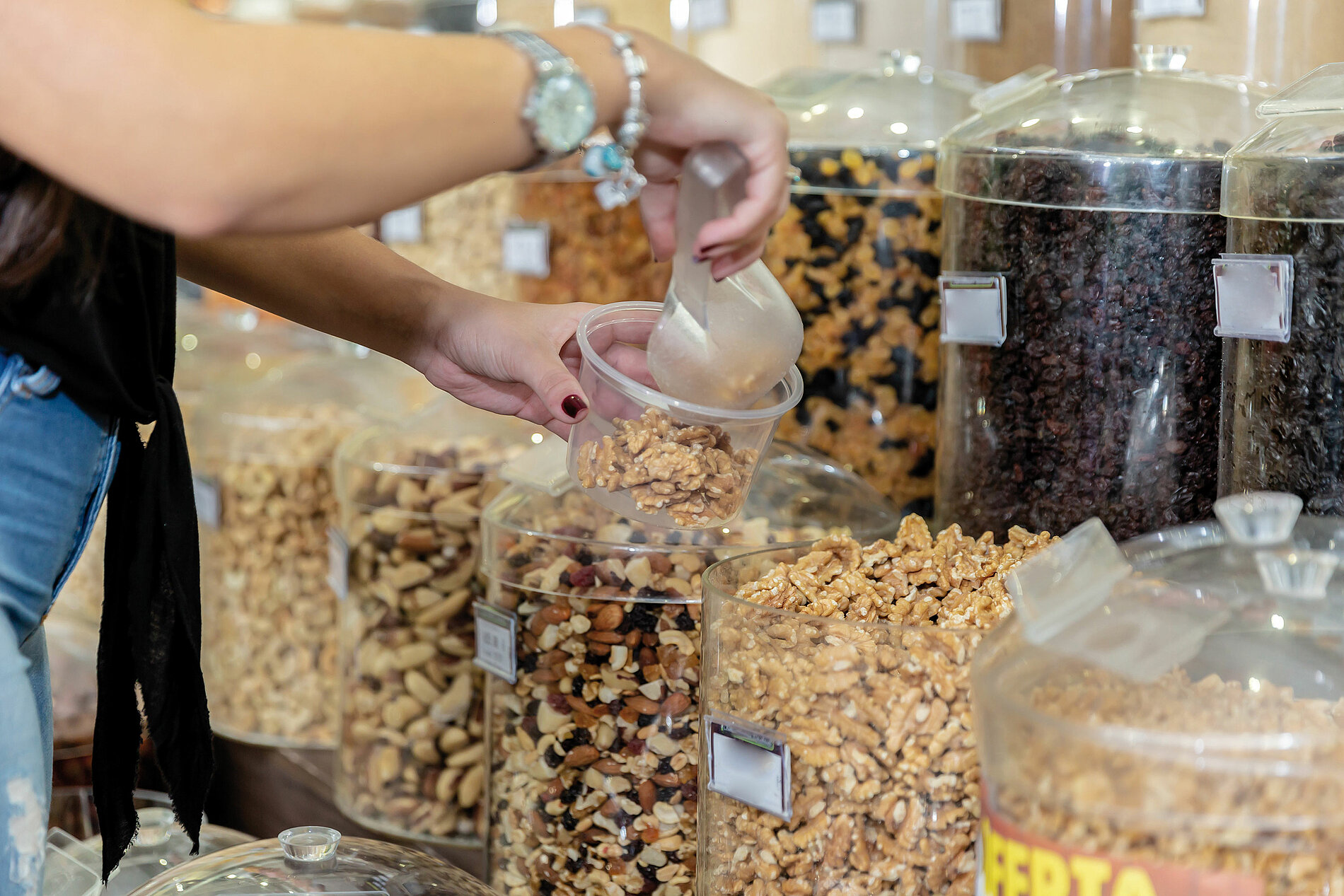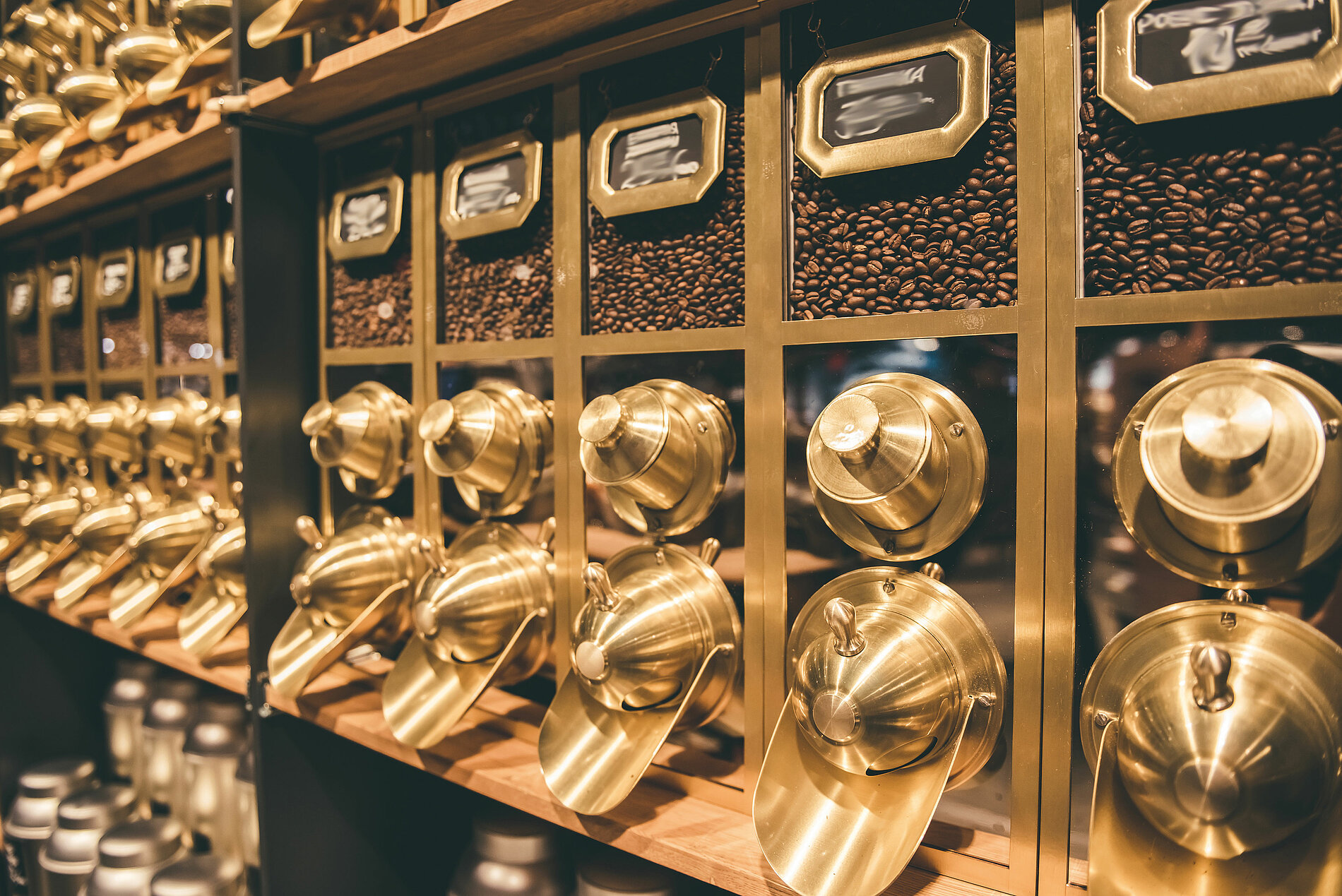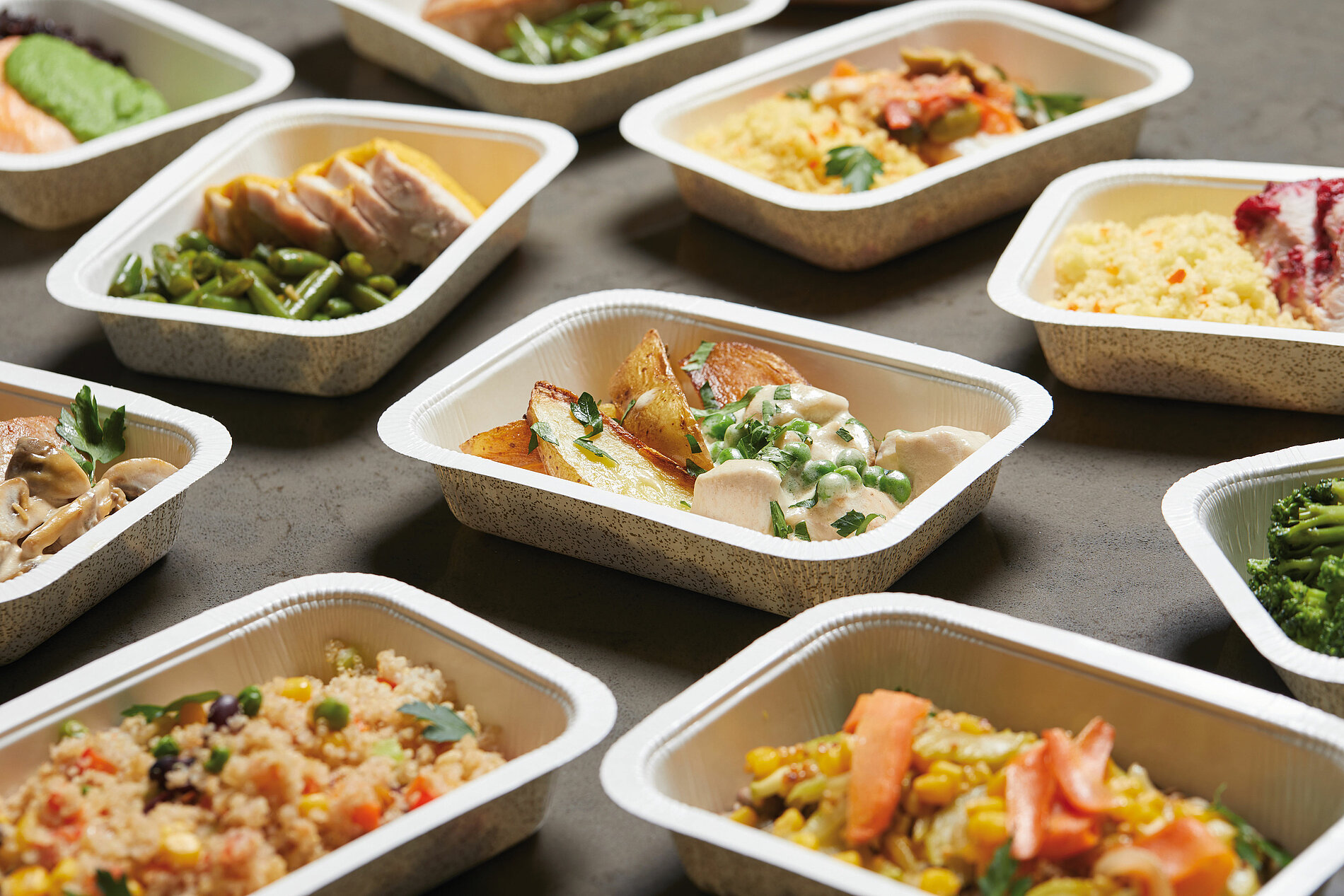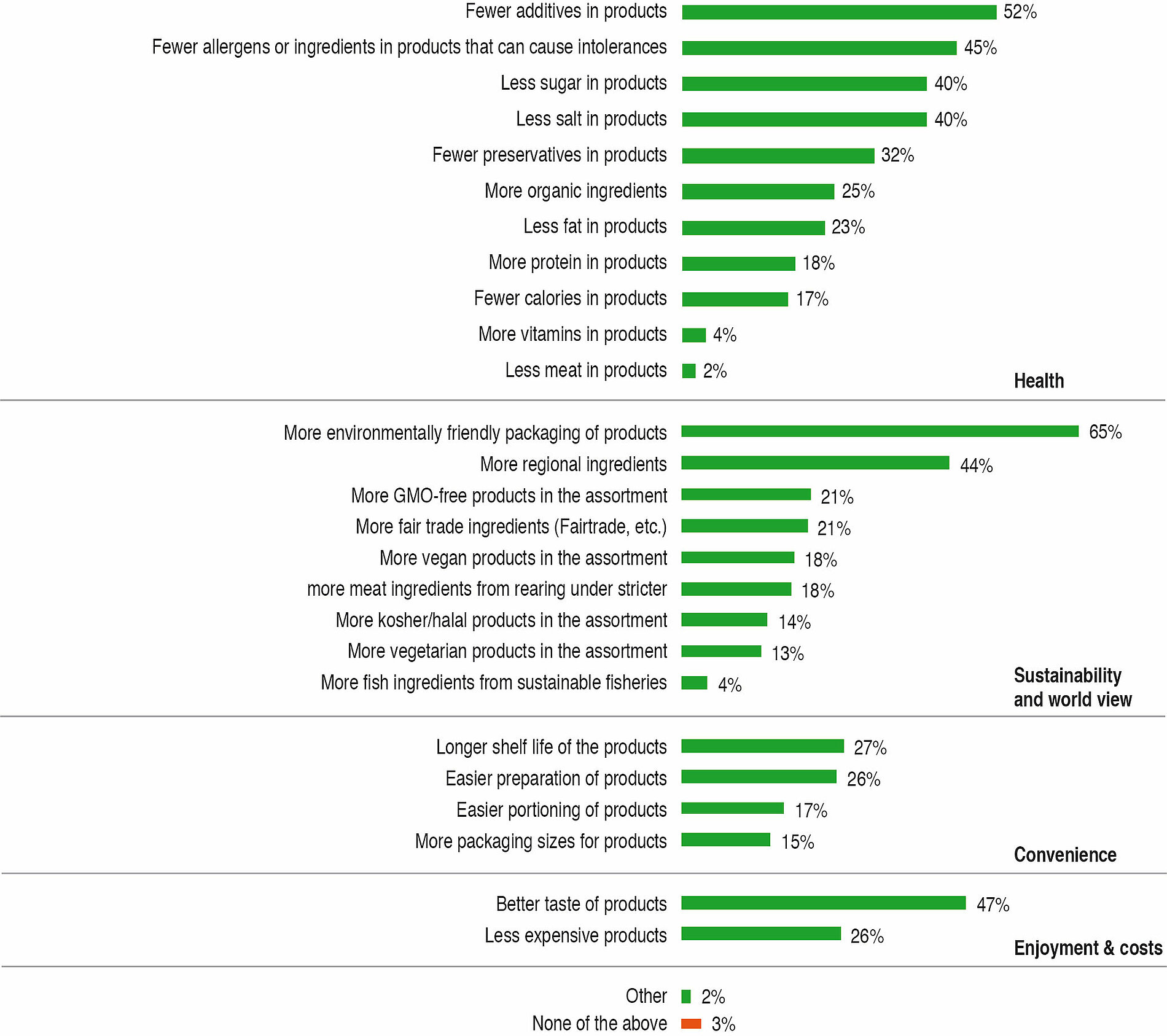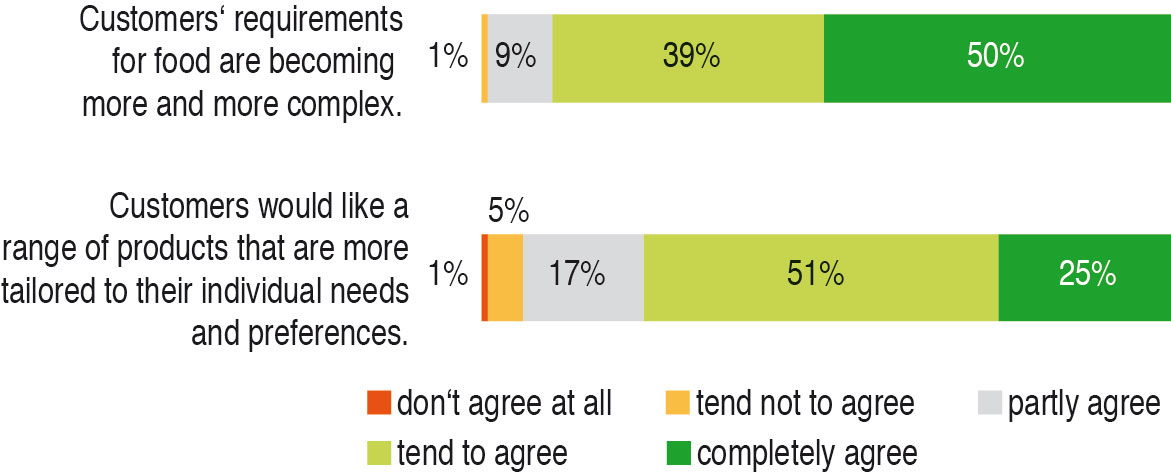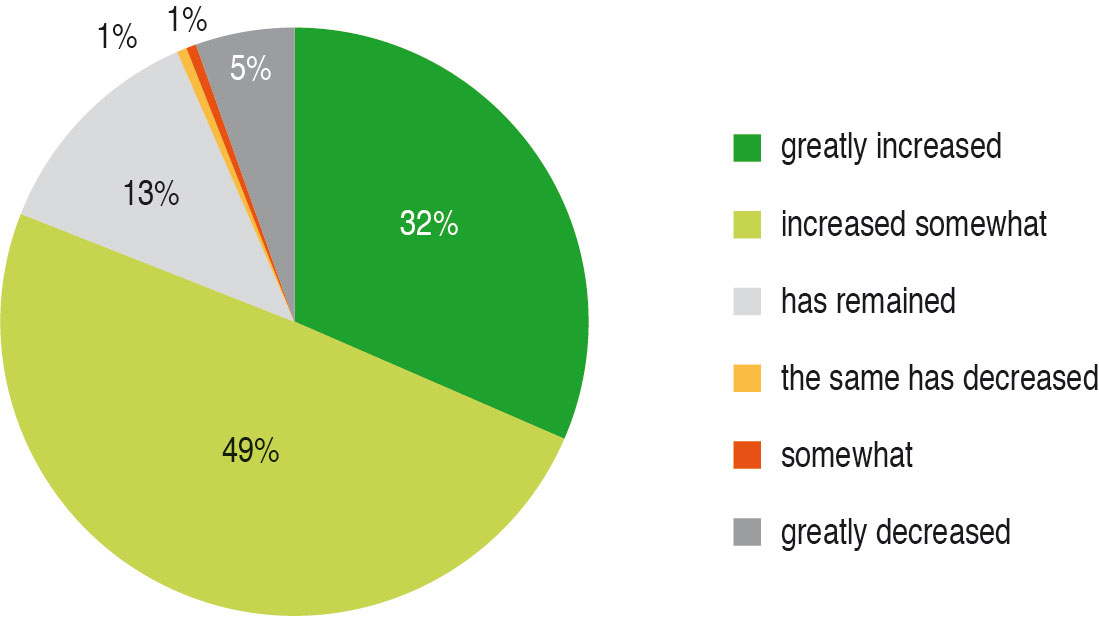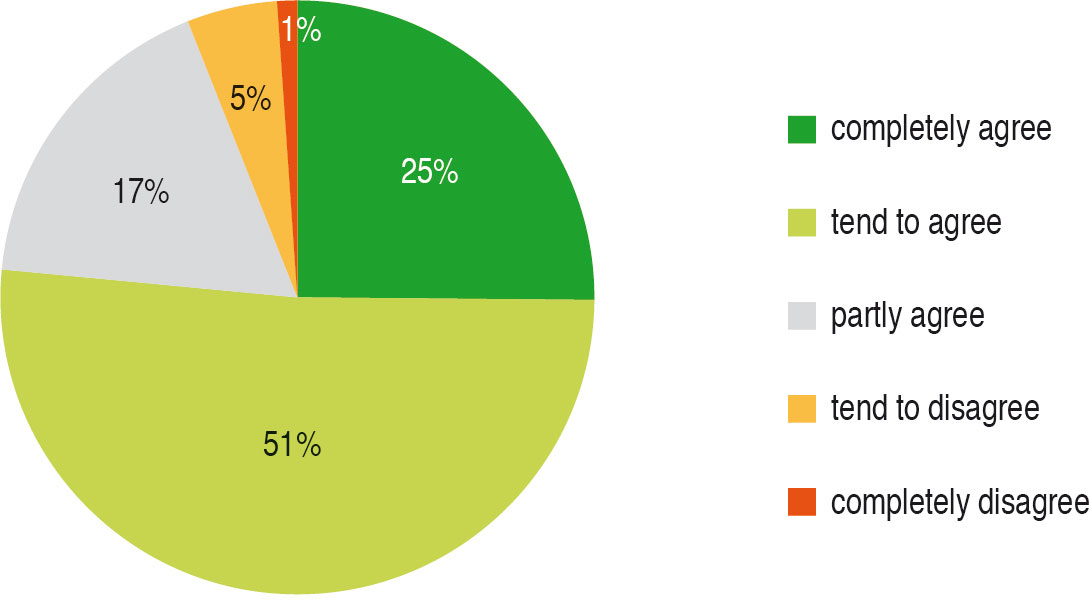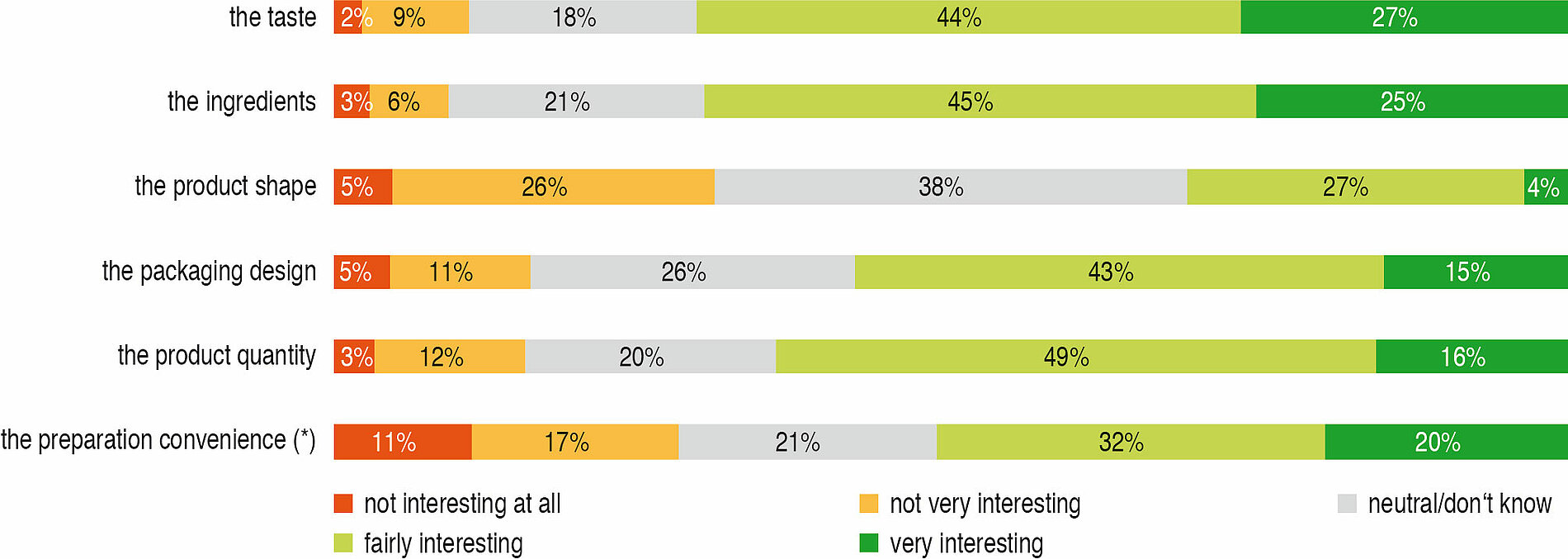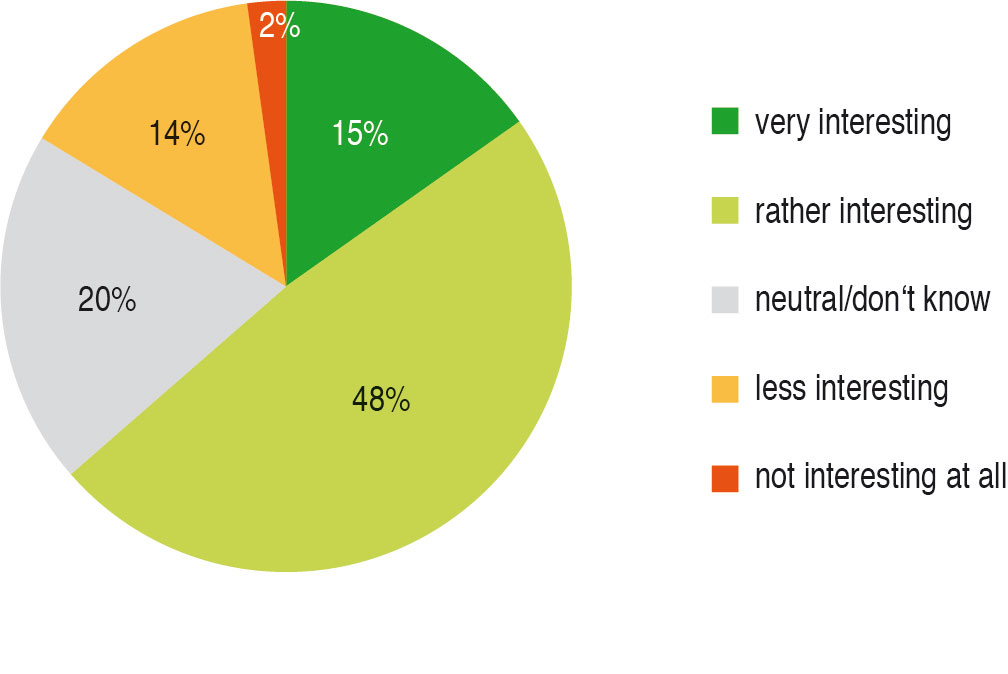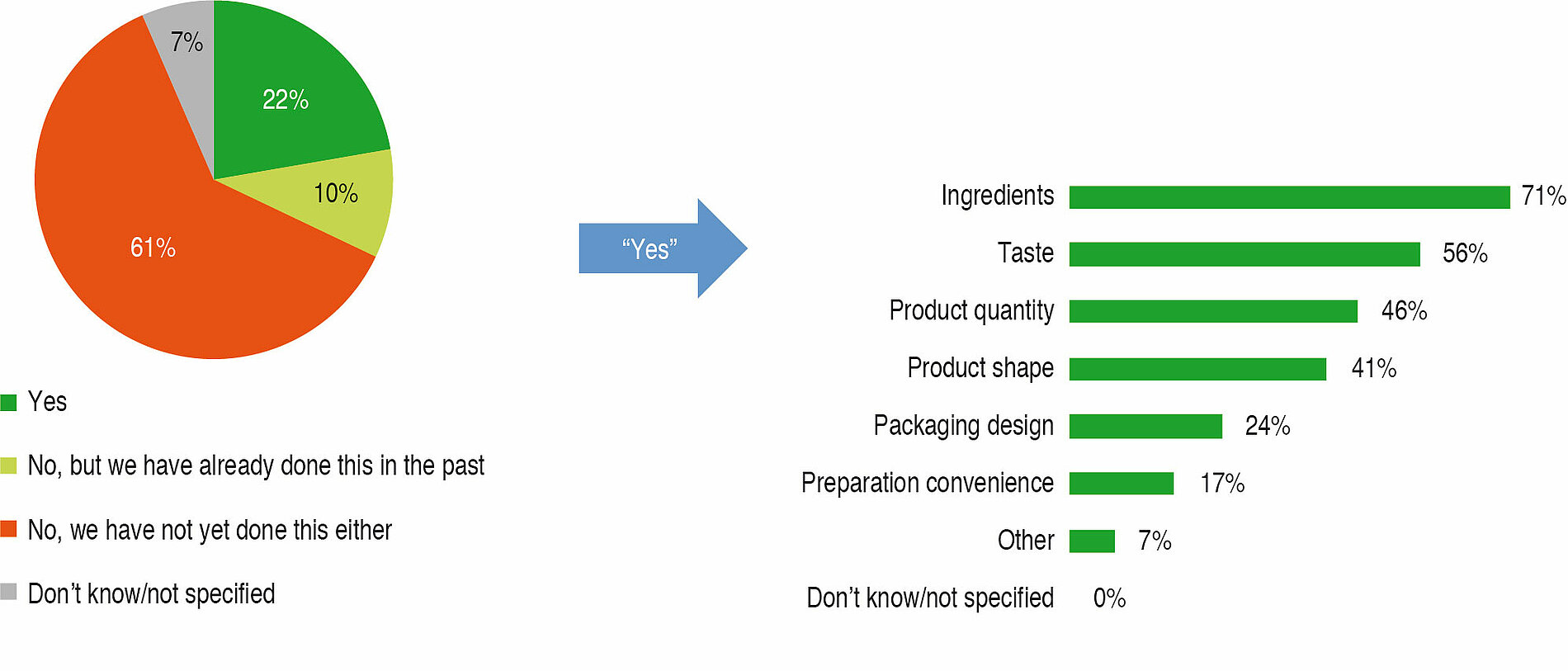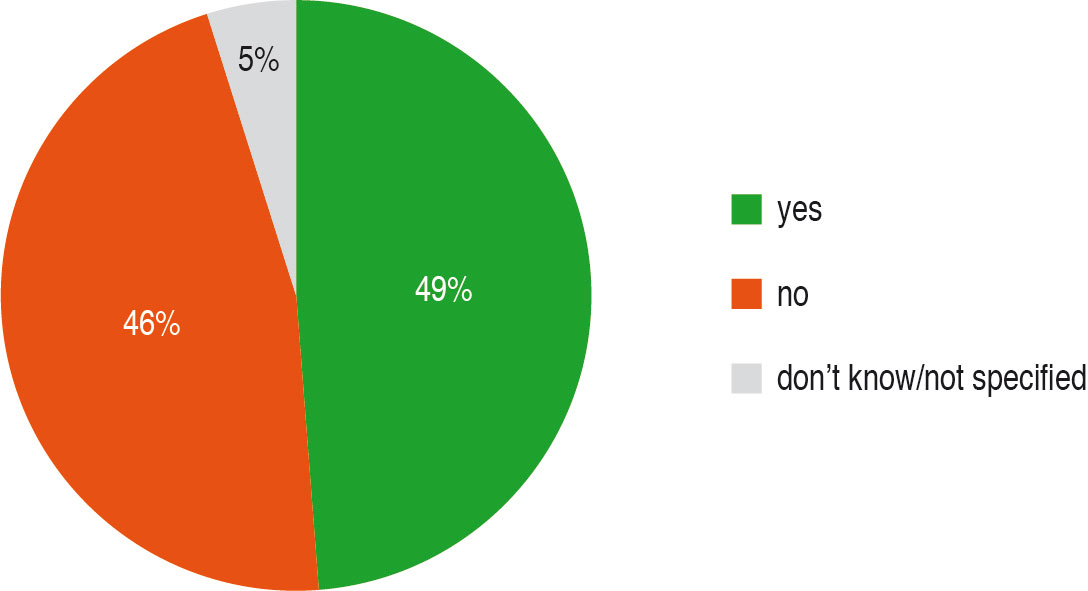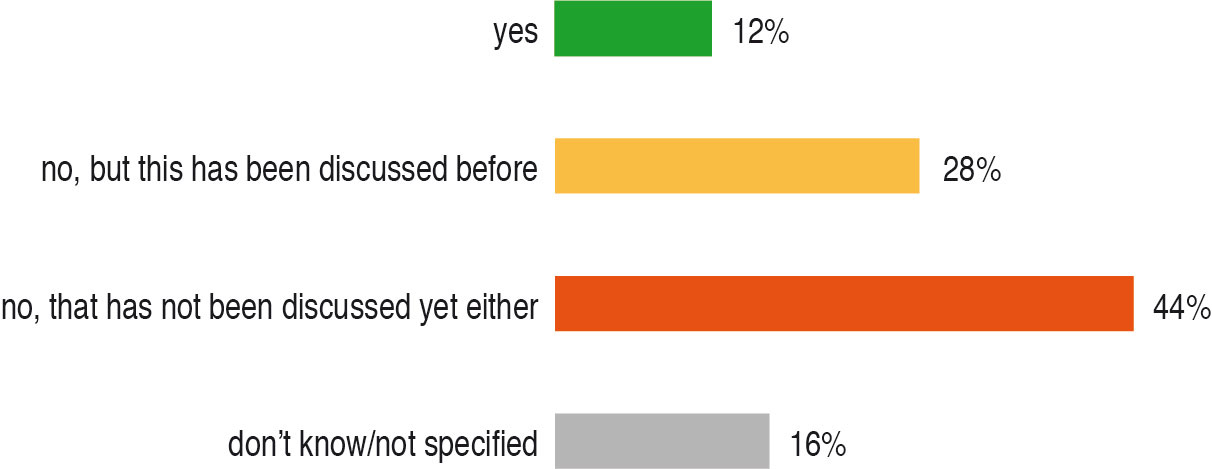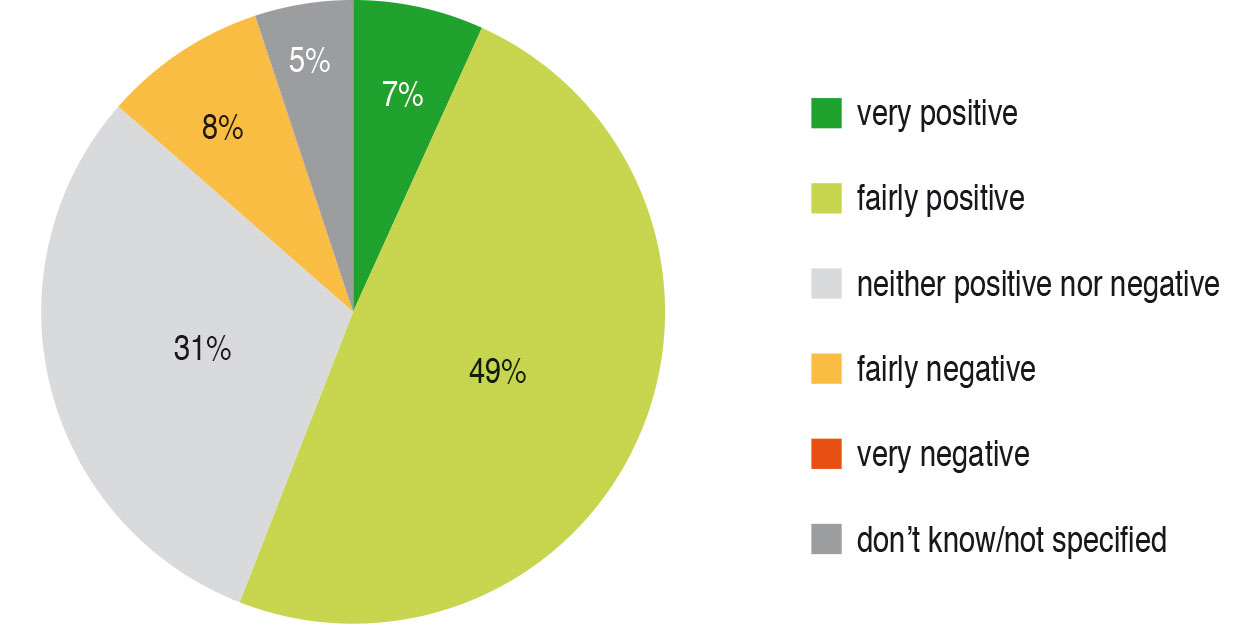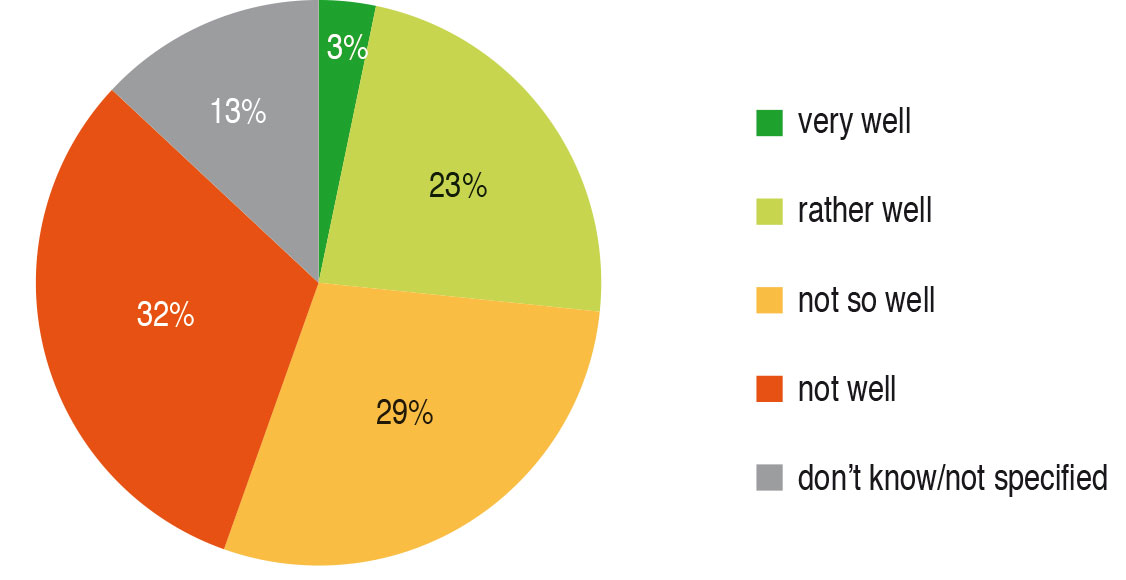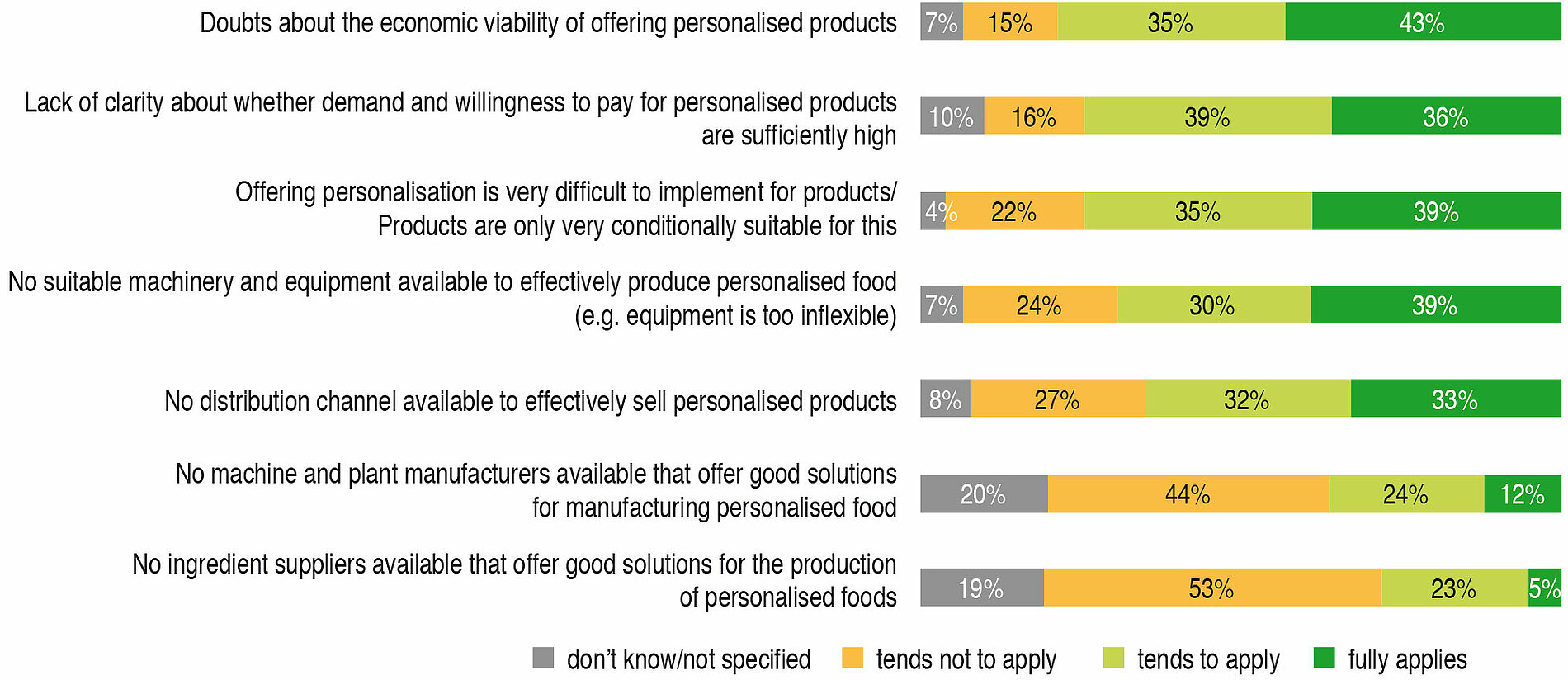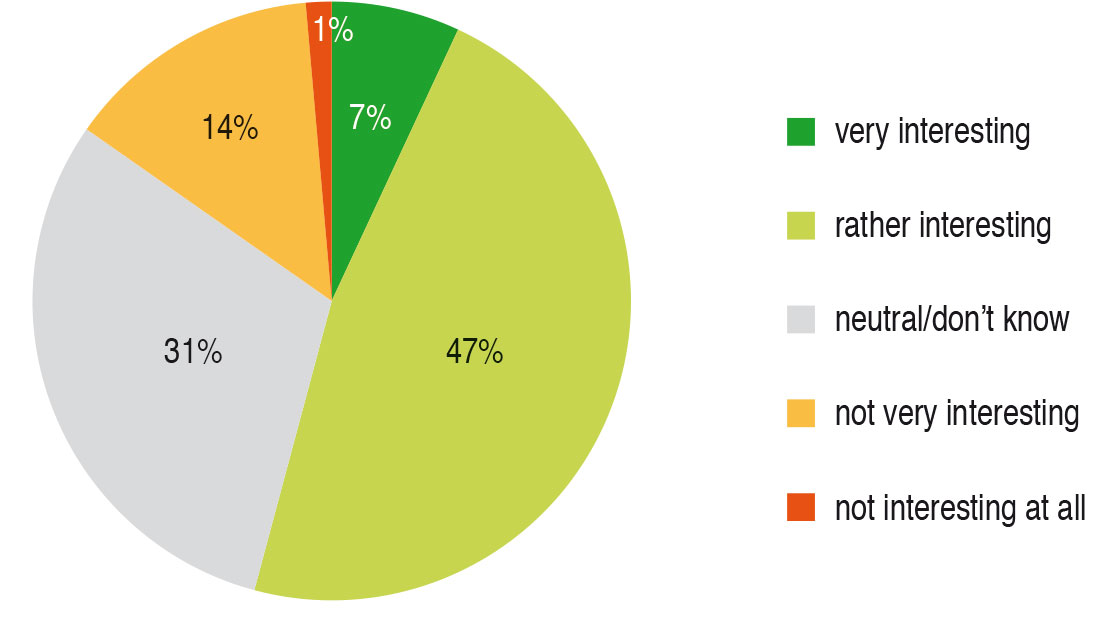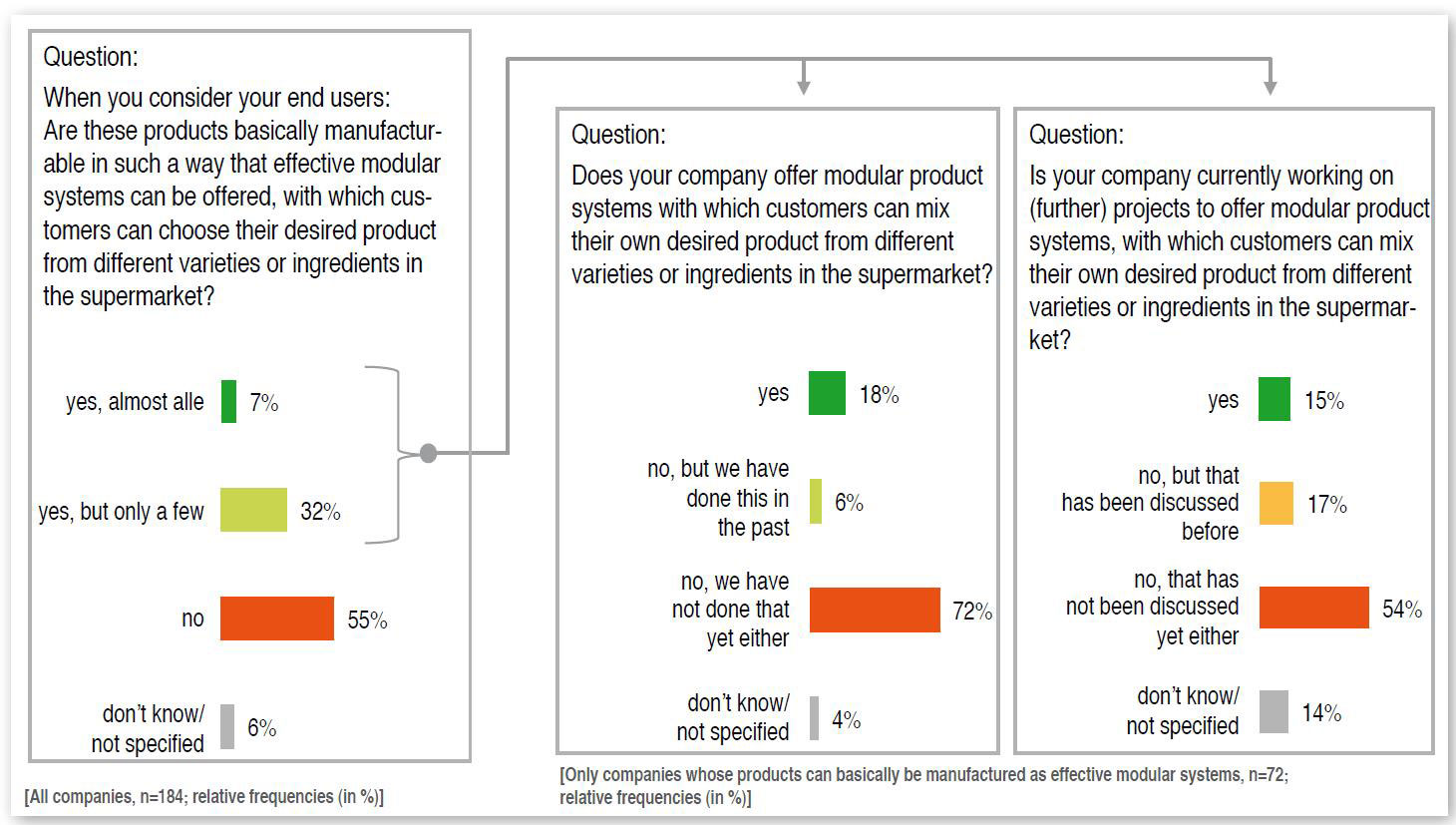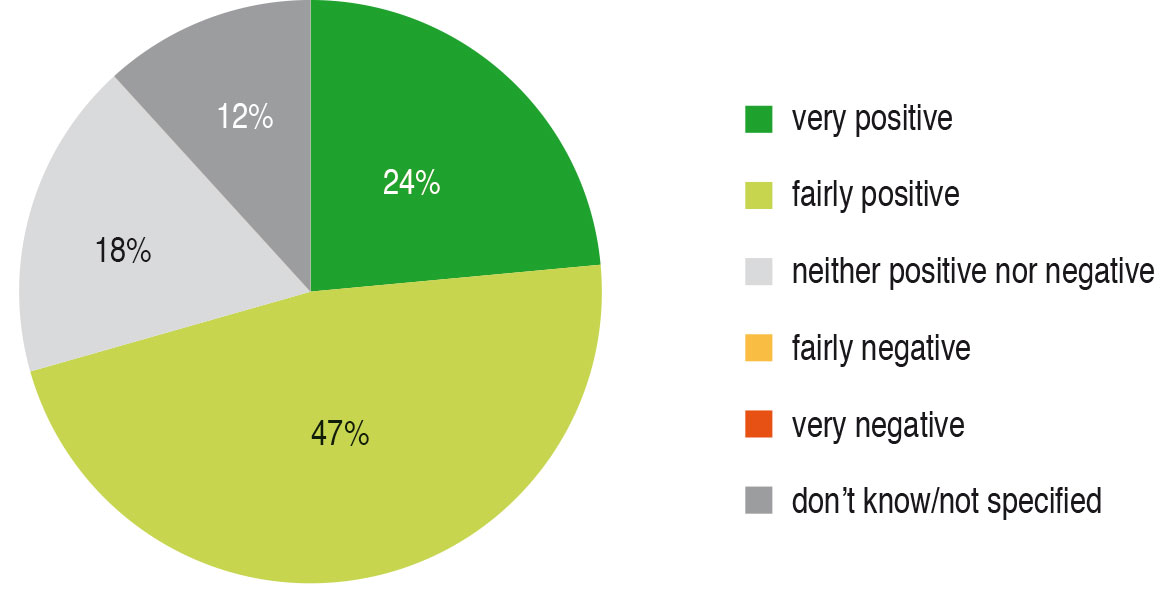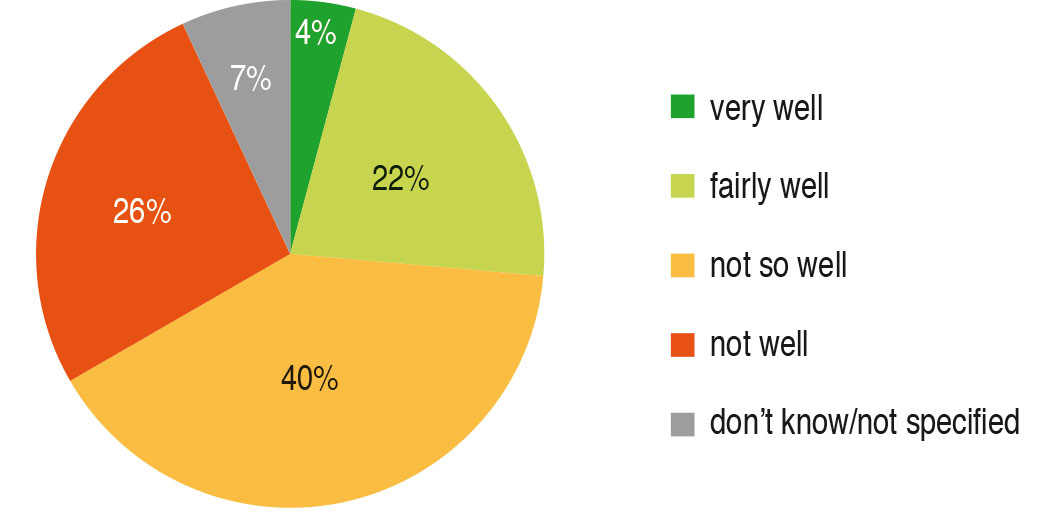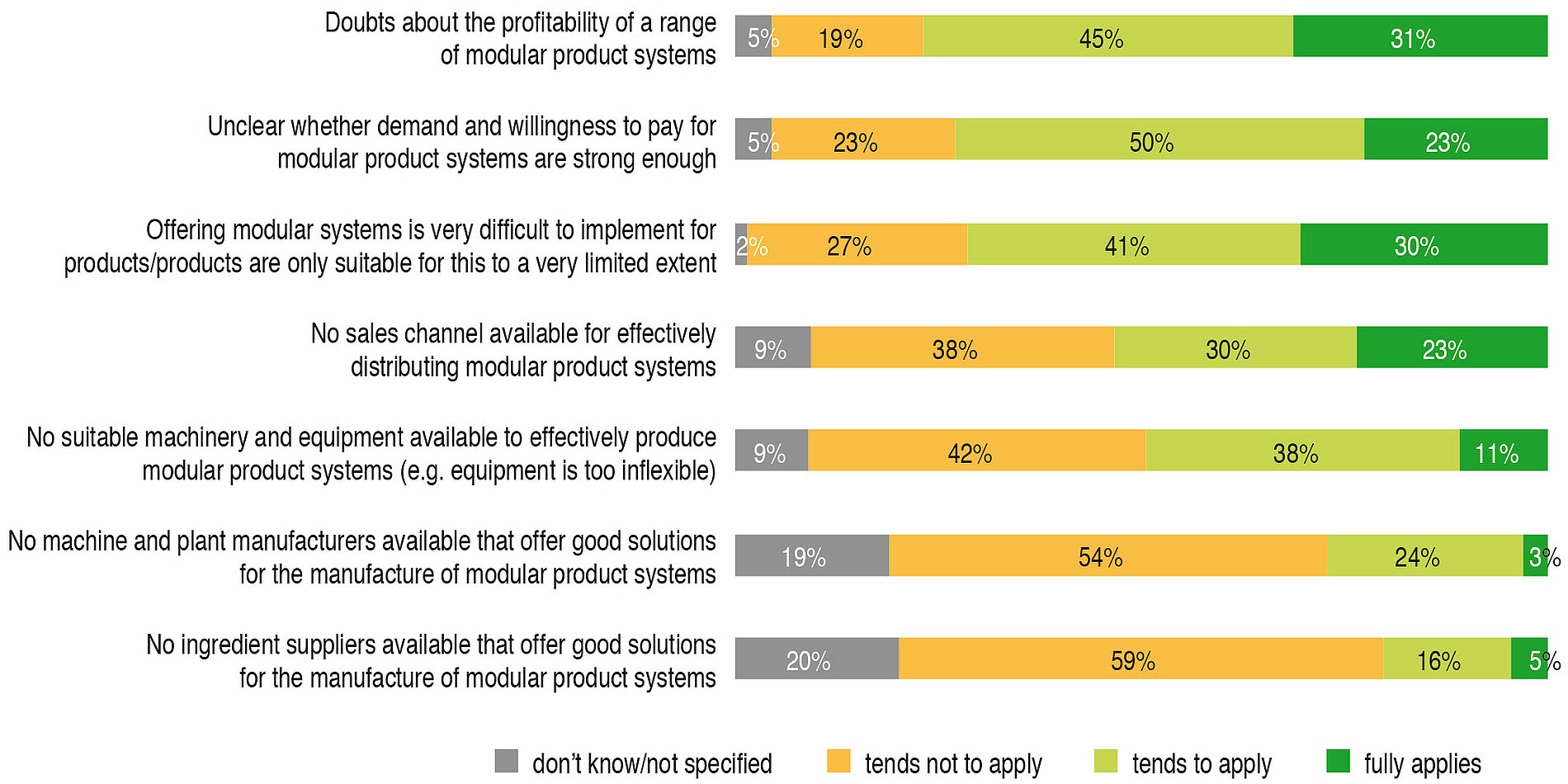Author
Prof. Dr. Holger Buxel
Professor of Marketing in the Food Sector at Münster University of Applied Sciences
Contact:
Simone Schiller
Managing Director DLG Competence Center Food
(DLG-Fachzentrum Lebensmittel)
S.Schiller@DLG.org
The study was conducted by the DLG (Deutsche Landwirtschafts-Gesellschaft – German Agricultural Society) in cooperation with Prof. Holger Buxel.
My Food – Personalisation and Nutrition
The personalisation of products is becoming a global mega trend in business and society. In almost all areas, today’s customers increasingly want more than just a range of standard products. They also look for products that are tailored to them and those to which they can add a personal touch. The internet and AI (artificial intelligence) are making it increasingly easy for consumers to generate customised product recommendations and to create and order their own customised or personalised products in seconds. Digitalisation and flexible manufacturing systems are increasingly enabling companies to adapt to customer needs for more personalisation.
This trend towards personalisation can also be observed in the area of nutrition and food. Essentially, this development can be clustered into three segments: personalised food, personalised nutrition concepts and personalised assistance for food shopping and nutrition.
| Personalised food | Personalised nutrition | Personalisation in food shopping and nutrition apps |
| Personalised foods are products that are adapted by manufacturers to meet personal customer needs. To this end, manufacturers usually offer customers various options for adapting the products to their personal taste, ingredient, shape, packaging design, quantity or preparation preferences. | Companies offer the creation of personalised nutrition concepts to better adapt nutrition to personal preferences and health needs. The customised nutritional concepts are often generated through analyses of metabolism, genetic profiles, health status, lifestyle and personal preferences. | Digital products (e.g. in the form of apps) are being developed for food shopping and nutrition that generate suggestions for shopping or consumption in real time based on the consumer’s personal characteristics and needs in order to simplify everyday life |
Personalisation offers in the food sector and in nutrition
Compared to standard products, personalised food can increase customer loyalty and willingness to pay. However, companies also express concerns. This is because the food industry has traditionally been characterised by a very wide range of products, offering customers many choices. Personalisation strategies also often require investment in processes and equipment, which can drive up costs and must pay off in the end.
Just as with personalised food, offering personalised nutrition concepts and aids for food shopping ultimately presupposes that there is sufficient consumer acceptance for them.
Against this background, companies in the food industry and food trade, as well as consumer and health organisations, are currently faced with the question of whether and how they should align their products and information offerings with the trend towards greater personalisation in the food and nutrition sector. Here it is often unclear to what extent the personalisation trend is already pronounced in the market and what development potential offers in the three areas of “personalised food”, “personalised nutrition concepts” and “personalised aids for food shopping and nutrition” have.
In order to meet this need for information, the DLG (Deutsche Landwirtschafts-Gesellschaft – German Agricultural Society), in cooperation with Prof. Dr. Holger Buxel (Münster University of Applied Sciences), conducted the study “My Food – Personalisation and Nutrition” in summer 2019. Consumer, company and expert surveys were conducted with the aim of gaining insight into the status quo of acceptance and the offer of personalised food, nutrition and assistance concepts. The main results are summarised in three publications.
This publication deals with part one of the study, personalised food.
| Study | My Food – Personalisation and Nutrition | ||
| Part | (Part 1) Personalised food | (Part 2) Personalised nutrition | (Part 3) Personalisation in food shopping and nutrition apps |
| Focus |
|
|
|
Publication series My Food – Personalisation and Nutrition
Introduction
The food market is currently seeing a growing range of personalised food products. Two types of offers can be distinguished here:
- Personalised foods that are adapted by manufacturers to meet personal customer needs. To this end, manufacturers offer customers options when ordering or purchasing, such as how products can be adapted to personal taste, ingredient, shape, packaging design, quantity or preparation preferences (Fig. 1).
- Modular product systems, where customers can mix their own desired product from a set of different varieties, ingredients or building blocks at the point of sale.
Consumers benefit from personalised food by having their individual dietary and product preferences taken into account more than is the case with standard products. Personalised food offers companies the opportunity to generate an increased willingness to buy and pay for their own products by better satisfying customer needs and to differentiate themselves from the competition. Personalised food is therefore being discussed as an important trend topic.
The potential that personalised food can unleash is limited on the one hand by the fact that there is already a wide range of products on offer for many foods, which already gives customers many options to choose from. On the other hand, the implementation of a personalised food range in companies often requires investments in modified processes and facilities that have to be profitable.
The question of what concrete opportunities and development prospects personalised food offers is therefore largely dependent on the following questions:
- What relevance and acceptance do personalised food offers have from the consumer’s point of view?
- What are the possibilities and the status quo of offering personalised food in companies in the food industry? To answer these questions, a consumer, company and expert survey was conducted (Fig. 2). First the results from the consumer survey, then those from the business survey will be considered.
The six “typical” offers of personalisation in food
Examination set-up: Personalised Food |
Personalised foods are products that are adapted by manufacturers to meet personal customer needs. To this end, manufacturers usually offer customers various options for adapting the products to their personal taste, ingredient, shape, packaging design, quantity or preparation preferences. A consumer, company and expert survey was conducted to analyse the relevance and supply of personalised food. 1. Consumer survey (pages 6 to 12): The relevance and acceptance of personalised food offers from the consumer’s point of view was investigated. For this purpose, a representative consumer survey with n=1,000 was conducted in July 2019. The focus was on the following questions:
2. Company survey (page 13 to 23:) The study investigated the status quo of the offer of personalised food from a company’s perspective and how the future development of the trend towards greater personalisation of food is assessed. For this purpose, a survey was conducted from July to August 2019 among 184 companies from the food industry that produce food for end consumers. The focus was on the questions:
3. Expert survey (page 24 to 25): To complement the consumer and company survey, experts from the food industry were interviewed on selected aspects of personalisation |
Fig. 2: Research structure of the study part “Personalised Food”
1. Consumer Perspective
Relevance and Acceptance of 1Personalised Food
The consumer survey focused on the question of what relevance and acceptance personalised food offers have from the consumer’s point of view. New offers attract interest in the market above all when consumers have needs that are not well covered by products already available on the market and when the new products can do this significantly better. Therefore, in a first step, it was considered how large the share of consumers in the market is to be estimated whose needs are not yet sufficiently well covered by the existing range of “standard products” and for whom a noticeable additional benefit could be created through personalisation offers.
How well does the current food supply meet personal needs from the consumer’s point of view?
Respondents were presented with some questions and statements about their typical supermarket shopping experiences. In terms of how suitable the respondents rate the available product range to their needs, it becomes apparent:
- Every third respondent (34%) agrees with the statement that there are assortment groups in packaged food where they often have problems finding a product in the supermarket that is well suited to their personal needs (Fig. 3).
- One in four respondents (26%) state that it happens often or very often that they want to buy something from a food group in the supermarket and are also faced with a larger selection of different products, but do not buy anything despite the selection, because the products offered do not fit their personal needs.
These respondents, who often or very often do not buy a product because the selection does not fit their personal needs, were asked about the reasons for their non-purchase. The most frequently cited reason is that there is no product is offered that contains the ingredients and nutrients that suit their personal dietary needs (37%).
Accordingly, it can be stated that there are definitely larger consumer groups for whom the current offers in the supermarket in some product areas do not meet the personal needs of the consumer. Personal needs not sufficiently well covered. These consumers can be classified as a potential target group for personalised food.
How interesting are different personalisation options for food from the consumer’s point of view?
Building on the consideration of the status quo of demand satisfaction through “standard products” in the supermarket, it was investigated for which food characteristics personalisation appears interesting from the consumer’s point of view. There are six “typical” starting points for personalising food: personalising the taste, the ingredients, the product form, the packaging design, the product quantity and the convenient form of preparation (Fig. 1). Along these starting points, the participants were asked whether there were any specific foods for which an offer to produce the product according to personal needs and preferences would be interesting for them. Those who answered in the affirmative were also asked for which products this was the case. The answers are summarised in Figures 4 and 5.
Are there very specific foods where an offer to produce the product according to your personal needs and preferences is interesting in terms of ...
Figure 4: Interest in the different approaches to personalisation
For which packaged foods is an offer to manufacture a product according to your personal needs and preferences interesting in terms of ...
[Only respondents with interest in the personalisation option]
Figure 5: Product groups for which personalisation of taste and ingredients is interesting
It turns out:
- Personalisation of taste is most frequently rated as personally interesting (36% of respondents). Yoghurt, ready meals, sausage, meat, pizza and cheese are named as relevant product (groups) for personalising taste.
- Personalisation of ingredients is also rated as personally interesting by 28% of respondents. Here, ready meals, yoghurt, muesli, vegetables, sausage, salad, spices, pizza, bread and dairy products/cheese are named as relevant product (groups) for personalisation of ingredients (Fig. 5).
- For almost one in five, personalisation of the quantity of food products is also of personal interest (19% of respondents), for personalisation of preparation convenience it is 12%, for the product shape
- 10% and for packaging design finally 7% of respondents.
Asked whether one has ever bought a packaged food product in a supermarket or on the Internet where the production was done according to personal needs and preferences along the “typical” starting points for personalisation, it can be seen (Fig. 6):
- 40% of the respondents have already bought a product that was manufactured according to their personal needs and preferences in terms of taste.
- In terms of product quantity, 37%, in terms of ingredients 36%, in terms of product shape 23% and in terms of packaging design 22% bought a product that was made according to their personal needs and preferences
Overall, this shows that many consumers are generally positive about the offer of personalised food. It is therefore not surprising that many consumers have already bought personalised food. Consumers are most interested in personalising the taste and ingredients.
How interesting are modular systems for food from the consumer’s point of view?
In addition to customised production, greater personalisation of food can also be implemented through modular systems with which customers mix their own desired product from different varieties, ingredients and building blocks in the supermarket. Typical examples of such modular systems are muesli mix or sweets mix product ranges.
When asked about the general interest in such modular systems for food, it became apparent:
40% of the respondents state that there are foods for which it is interesting for them personally to mix their own desired product from different varieties or ingredients in the supermarket (Fig. 7).
The interviewees who are interested in modular systems were also asked about the products for which it is interesting for them personally to mix their own desired product from different varieties or ingredients in the supermarket. The answers are broad and refer to many products and product groups, with the product groups salad, muesli, sweets, fruit, vegetables, chocolate, bread, nuts, yoghurt, pasta, sausage, chocolates, cheese and tea being mentioned more frequently (Fig. 8).
It can be seen that for broad consumer segments, an offer of modular systems – similar to an offer of personalised food – can be quite interesting.
How attractive are existing personalised foods from a consumer perspective?
If consumers are interested in an offer of personalised food or a modular system, this does not mean that this interest will develop in the same way for all types of products and personalisation offers. In order to gain an insight into the level of interest in concrete personalised food offers that can be observed in the market, a total of ten such offers of personalised food were presented to the respondents, including (Fig. 9).
three offers of personalisation of taste and ingredients,
two offers of personalisation of product form
two offers of personalisation of packaging design and
three offers of modular systems

Are there foods for which it is interesting for you personally to mix their own desired product from different varieties or ingredients in the supermarket?
| In the following we will show you some offers from the food sector. Just imagine ... |
| Muesli (modular system) In your local supermarket, you can put together your own muesli according to your own taste preferences from a variety of muesli ingredients. It costs the same as a packaged muesli. |
| Sweets (modular system) Your local supermarket offers you the chance to put together your own mix of sweets, such as small chocolate bars or fruit gums, according to your own taste preferences. A self-made mixture costs the same as if you were to buy the same sweets separately. |
| Jam (packaging design) Your favourite brand of jam offers you the option of designing the packaging yourself according to your own needs. On the Internet, you can create your own favourite design from various design templates and elements and freely expand it with photos and text, e.g. a personal slogan or a photo of something important to you (e.g. holiday photo with friends/partner). The jam with its individual packaging is simply ordered and paid for over the Internet and sent either to the customer’s home or to the nearest supermarket for collection. |
| Biscuits (product shape) Your favourite brand of biscuits offers you the option of having biscuits made in shapes and colours of your choice, e.g. in the shape of stars, hearts or letters and in your favourite colours. On the Internet, you can choose your favourite shapes and colours for the biscuits yourself from various templates. The biscuits with the shapes and colours of your choice are simply ordered and paid for over the Internet and sent either to your home or to the nearest supermarket for collection. |
| Coffee (taste & ingredients) Your preferred brand of coffee gives you the opportunity to make your coffee according to your own taste preferences. To do this, you can choose your favourite beans on the Internet from delicious coffees from a wide variety of countries around the world (e.g. Guatemala, Africa). You can then add different flavours (e.g. raspberry, vanilla, chocolate, chilli, caramel) to the coffee, which are absorbed directly into the bean and contain no calories. In the last step, you can select the correct grind for your preparation method (e.g. whole beans, for filter machine). The coffee is simply ordered and paid for over the Internet and sent either to your home or to the nearest supermarket for collection. |
| In the following we will show you some offers from the food sector. Just imagine ... |
| Frozen food menu (modular system) In your local supermarket you can put together your own menu from different frozen ingredients such as meat, fish and vegetables. You can take the menu you have created home with you, where you simply heat it up (e.g. in the microwave or in a pan). It costs exactly the same as other frozen ready meals in the supermarket. |
| Fruit juice (taste & ingredients) Your favourite brand of fruit juice offers you the opportunity to have a fruit juice drink made to your own taste preferences. To do this, you can choose from over 20 fruits on the Internet and mix them as you like. The fruit juice is simply ordered and paid for over the Internet and sent either to your home or to the nearest supermarket for collection. |
| Fruit gums (product shape) Your favourite brand of fruit gums offers you the option of having fruit gums produced in shapes and colours of your choice, for example in the shape of stars, hearts or letters and in your favourite colours. On the Internet, you can choose your favourite shapes and colours for the fruit gums yourself from various samples. The fruit gums with the shapes and colours of your choice are simply ordered and paid for over the Internet and sent either to your home or to the nearest supermarket for collection. |
| Chocolate (packaging design) Your favourite brand of chocolate offers you the option of designing the packaging yourself according to your own needs. On the Internet, you can create your own favourite design from various design templates and elements and freely expand it with photos and text, e.g. a personal slogan or a photo of something important to you (e.g. holiday photo with friends/partner). The chocolate with its individual packaging is simply ordered and paid for over the Internet and sent either to the customer’s home or to the nearest supermarket for collection. |
| Bratwurst and barbecue sausages (taste & ingredients) A butcher shop offers you the opportunity to have bratwursts or barbecue sausages made individually according to your own taste preferences. To do this, you can select your preferred type from various types of sausage (e.g. pork, poultry) on the Internet, which you can then individually adapt to your taste and refine with over 80 ingredients. Various vegetables (e.g. peppers, peas, olives), herbs and spices (e.g. garlic, wild garlic, horseradish) are available for refinement. Unusual ingredients such as different types of nuts, fruit, cheese or whisky are also available. The sausage is simply ordered and paid for over the Internet and sent either to your home or to the nearest supermarket for collection. |
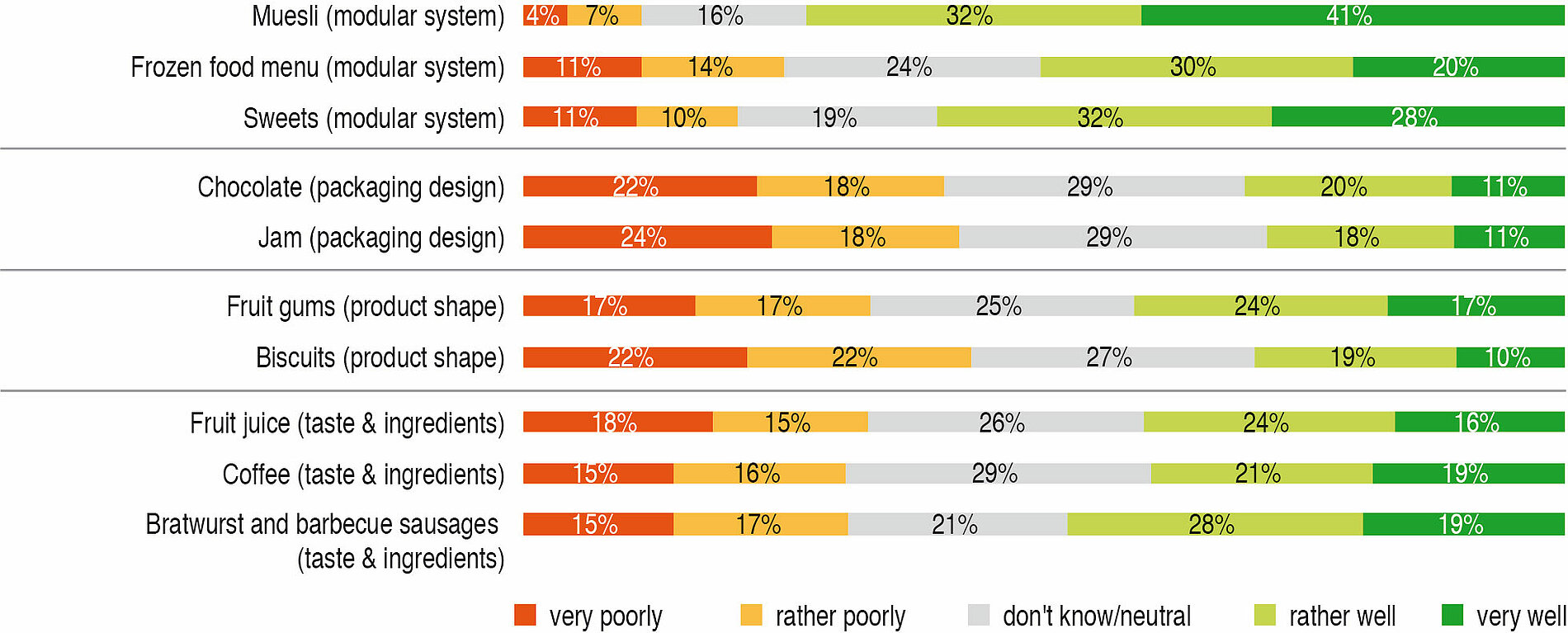
How well can you imagine making concrete use of these offers from the food sector?
Fig. 10: Attractiveness of personalised food products
The individual respondents were each presented with up to six of these offers based on a multi-stage random selection process (which took into account the fundamental product relevance for the respondents and excluded duplicate queries on individual personalisation options). The respondents were asked to indicate how well they could imagine using the offer (Fig. 10):
- For the three offers of personalisation of taste and ingredients, the proportion of respondents who could imagine using the offer very well is between 16% and 19%.
- In the case of the two offers of personalisation of the product form, 10% and 17% of the respondents can very well imagine making concrete use of the offer.
- In each case, 11% of the respondents can very well imagine making concrete use of the two offers of personalisation of the packaging design.
- Finally, for the three modular systems, the proportion of respondents who could very well imagine making concrete use of the offer lies between 20% and 41%.
Interim conclusion on consumer survey
Overall, the results show that offering personalisation of food is definitely interesting for many consumers and can generate added value. This applies both to offers of personalised foods, which are adapted by the manufacturers to the personal needs of the customer, and to offers of modular product systems, in which customers mix their own desired product from different varieties, ingredients and building blocks in the supermarket. Personalisation offers in the area of taste and ingredients are particularly interesting. Consumer interest in personalised food does not seem to be concentrated in just a few types of food, but exists across many different product groups.
All ten of the personalised food offers considered attract the interest of more or less large groups of respondents, ranging from 10% to 41% of the participants who can very well imagine using the respective offer. It is important to note that a respondent group of 10% in the German market represents a group of many hundreds of thousands of consumers who can be considered as a potential target group for such an offer. The personalisation offers that focus on modularity or taste and ingredients seem to have a higher appeal than the personalisation offers that focus on packaging design or product shape.
2. Company Perspective
Status quo of the product range and assessment of the trend towards greater personalisation of food
The survey results from the consumer survey show that offers of personalised food are obviously interesting for many consumers. But how is the personalisation trend currently being assessed by companies in the food industry and how is it being pursued in product range development? How many companies offer personalised food or modular systems and/or intend to do so? How do companies evaluate their possibilities for offering personalised food? And what experiences have companies had with offering personalised food so far?
These questions were the focus of the accompanying company survey, in which n=184 companies from the food industry that produce food for end consumers participated, including 80% companies from the food industry and 20% companies from the food trade. The random sample included companies of all sizes and core sectors of the food industry.
Which trend topics are currently being pursued by companies in product and range development, and does personalisation play a role in this?
In product and range development, companies in the food industry are currently facing a variety of challenges, ranging from optimising sustainability properties to those of application convenience to the health value of products (e.g. less sugar). In order to look at the importance of product personalisation from the companies’ point of view, the companies were asked in a first step which trend topics they are currently pursuing in product and assortment development, and how they assess the interest of customers in more personalised products.
Please mark all goals that your company is also currently actively pursuing in product and range development.
Fig. 11: Current trends in the development of products and assortments
Respondents were presented with a total of 26 goals that food manufacturers should achieve in their product and assortment development. The goals included the areas of health, sustainability and world view, convenience as well as enjoyment and cost. The respondents were asked to mark all goals that they are currently actively pursuing in their own product and assortment development (Fig. 11):
The goal most frequently mentioned by respondents is “more environmentally friendly packaging of products” (65% of respondents), followed by the goals “fewer additives in products” (52%) and “better taste of products” (47%).
In addition, various other goals also play a significant role: For example, the goal of “fewer allergens or additives in products that can cause intolerances” was mentioned by 45%, “more regional ingredients” by 44%, “less sugar in products” by 40% and “less salt in products” also by 40% of respondents.
With regard to the question of whether the companies are observing a growing demand for more individualised or more customised food, it becomes apparent:
- 89% of the respondents agree with the statement that the end consumers’ demands on food are becoming more and more complex (Fig. 12).
- Almost two thirds of the respondents (64%) must produce several product variants and varieties of a foodstuff in order to be able to sufficiently cover the individual needs of the individual customers. At the same time, 34% of respondents affirmed that standard products are becoming less and less trendy for average consumers.
- For 81% of respondents, the range of varieties and types of food offered to consumers has increased in recent years (Fig. 13).
Those respondents for whom the diversity of varieties and types of their food has increased in recent years were also asked how the diversity of varieties and types of individual characteristics of food has developed in the last 5 years. The following can be seen (Fig. 14):
- The most frequent growth is in the range of different flavours/aromas (85% of these respondents), followed by the range of product variants in relation to the sustainability characteristics of the ingredients (e.g. organic/fair trade/animal welfare/GMO-free variants) (73%).
- For 69% of respondents, the range of different packaging or product designs has also increased, for 63% the range of different packaging sizes.
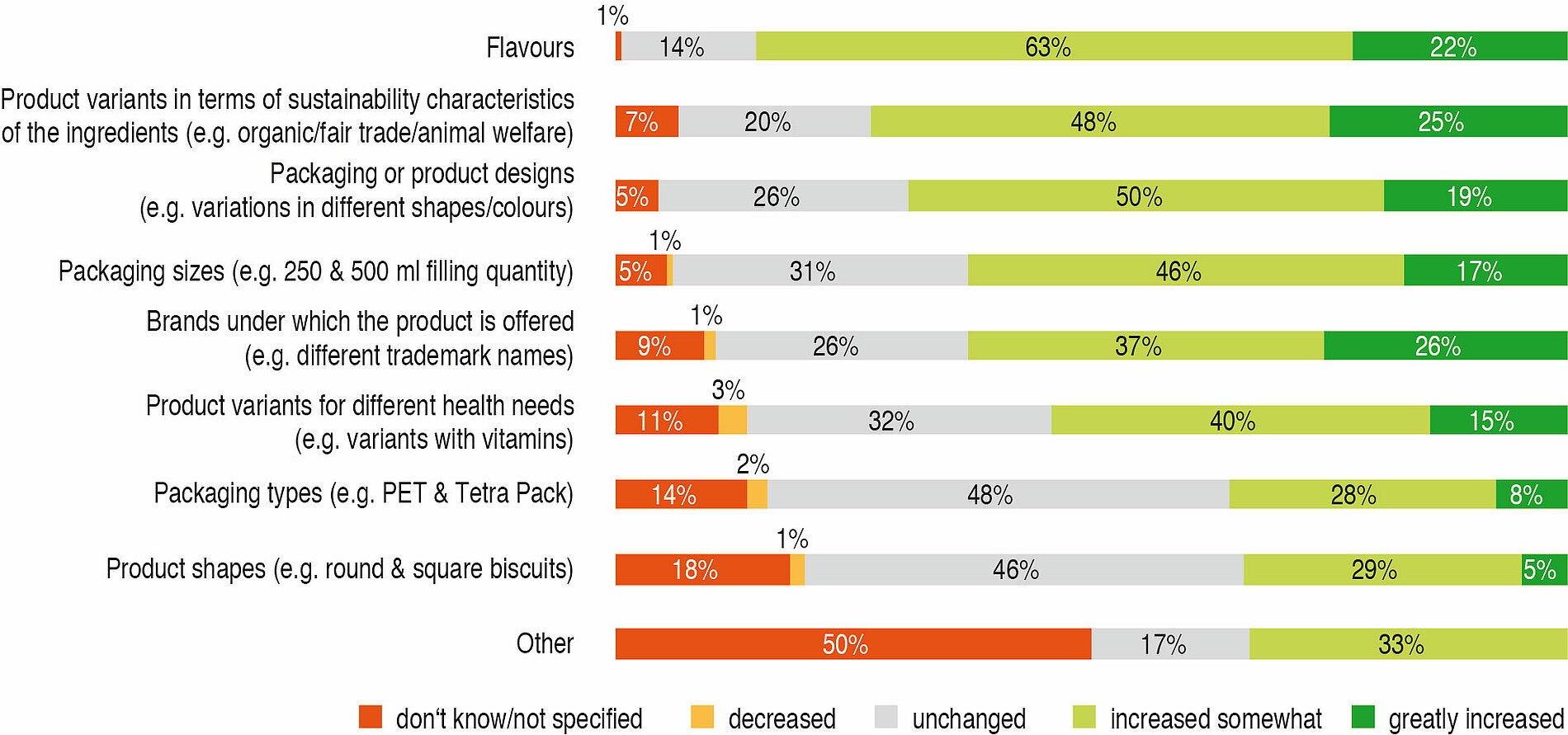
How has the diversity of varieties and types of your food for end consumers developed in the last 5 years for each of these individual characteristics? Range of different ...
Fig. 14: Motors of the diversity of varieties and types
- Also for more than half of these respondents, the range of different brands under which the product is offered has grown (63%), as has the range of product variants for different health needs (e.g. variants with vitamin or protein supplements; free from lactose, gluten) (55%).
- Finally, for 36% of respondents, the range of different types of packaging (e.g. PET & Tetra Pack) has increased, and for 34%, the range of different product shapes has increased.
With regard to whether it is expected that there will be a need for further differentiation of the variety and type diversity of the product range in the future:
- 76% of respondents agree with the statement that customers would like to see products that are more tailored to their individual needs and preferences (Fig. 15).
- With regard to an assessment of the characteristics of food for which your company will have to offer more variants or varieties in the future in order to be able to cover the personal needs of individual consumers sufficiently well, the following can be seen (Fig. 16):
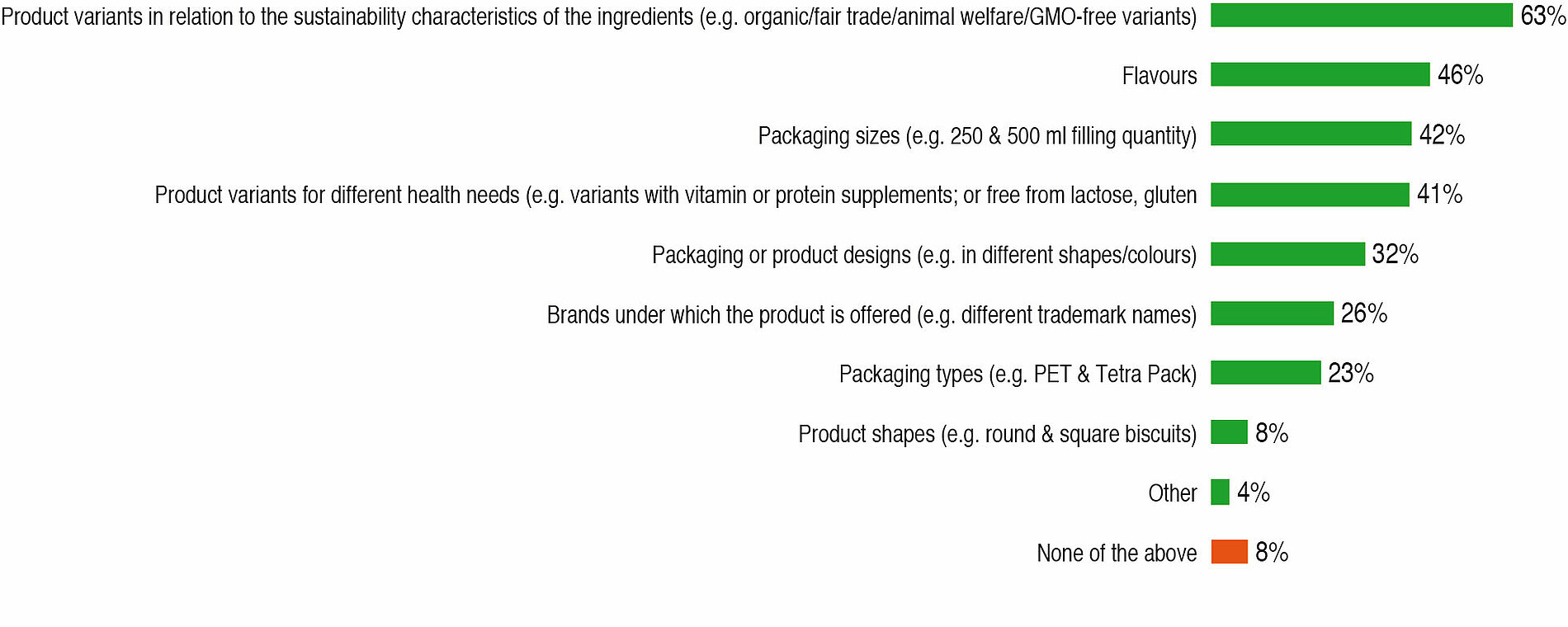
[Multiple choice question]
- 63% of the respondents estimate must offer more product variants in terms of the sustainability characteristics of the ingredients (e.g. organic/fair trade/animal welfare/GMO-free variants).
- When it comes to offering different flavours, 46%, when it comes to offering different packaging sizes, 42% and when it comes to offering product variants for different health needs, 41% of the respondents estimate that they will have to offer more product variants to this effect in the future.
- Finally, when it comes to offering different packaging and product designs, it is 32%, when it comes to offering different brands 26%, when it comes to offering different types of packaging 23% and when it comes to offering different product shapes 8% of the respondents estimate that they will have to offer more product variants to this end in the future.
For which of these characteristics do you estimate that your company will have to offer more variants or varieties in the future in order to be able to cover the personal needs of individual consumers sufficiently well? Range of different ...
Fig. 17: Assessment of interest in different personalisation options
Accordingly, it can be stated that the majority of companies in the food industry have already been pushing for greater differentiation of the variety and type of products they offer for years, but assume that many of their customers still want a range of products that are even more tailored to their individual needs and preferences.
How do companies assess consumer interest in personalised food?
In a second step, the companies were asked how they assess the concrete interest of consumers in personalised food produced according to personal needs and preferences:
- 27% of respondents think that offering personalised products in terms of taste is very interesting for their consumers; when offering personalisation in terms of ingredients, it is 25% and when offering personalisation in terms of product quantity, 16% of respondents.
- Consumer interest in personalising the packaging design (15% very interesting) and the product shape (4% very interesting) is rated as less interesting (Fig. 17).
- The fact that for consumers an offer of personalised products is very interesting, which is specifically adapted to the individual’s nutritional needs, think 15% of respondents (Fig. 18).
Many of the companies surveyed consequently estimated that personalised food in their sector could certainly be of interest to consumers.
And how interesting do you think it is for consumers to be offered personalised products that are specifically adapted to the individual’s nutritional needs?
(For example, by adding specific nutrients such as vitamins, proteins or calcium on request; or by omitting ingredients that you do not tolerate or like so well).
Fig. 19: Range of personalised food
What does the personalised food range look like?
Considering how many companies already offer personalised foods today and/or intend to do so, the following picture emerges: A total of 22% of the companies surveyed currently offer personalised foods that are produced according to the customers’ personal wishes and preferences. Another 10% say they do not currently offer personalised food, but have done so in the past (Fig. 19). There are differences between the types of companies surveyed:
- Of the companies surveyed in the food industry, 16% currently offer personalised food, compared to 49% of companies in the food trade.
- There is also some difference in the proportions of companies that do not currently offer personalised food, but have done so in the past. The figure is 6% for companies in the food industry and 24% for companies in the food trade.
The companies that have personalised food in their programmes today ...
- ... most frequently offer personalisation of ingredients (71%), followed by personalisation of taste (56%) and product quantity (46%). Only 24% of these companies offer personalisation of the packaging design, and only 17% offer personalisation of the preparation convenience (Fig. 19).
- ...were also asked whether they offer products that are specially adapted to the personal nutritional needs of individual consumers, e.g. by adding specific nutrients such as vitamins, proteins or calcium to food on request, or by omitting ingredients that a consumer does not tolerate or like very well. This is the case for 49% (Fig. 20).
With regard to the future, a total of 12% of all companies surveyed are currently working on (further) projects to offer personalised food. In another 28% of the companies, no projects are currently being carried out, but the topic has been discussed before (Fig. 21).
- Those companies that are currently working on (further) projects to offer personalised food are most often concerned with personalising ingredients (86%), followed by personalising taste (59%), product quantity (41%) and preparation convenience (36%). 27% of these companies are working on personalising the packaging design, 23% on personalising the product shape.
- The share of companies that are currently working on personalisation projects is larger among the surveyed companies in the food trade with 22% than among the companies in the food industry with 10%.
- 26% of all companies state that they are aware of competitors in their sector who offer personalised food. Among the companies in the food trade it is 38%, among the companies in the food industry 23% of the respective respondents.
The study also investigated what experience companies have had with offering personalised food so far.
- 56% of businesses that offer personalised food today or have offered it in the past would rate the experience of offering personalised food so far as positive overall (Fig. 22).
- These experiences with the offer of personalised food do not differ significantly between the surveyed companies in the food industry and the surveyed companies in the food trade.
Companies that offer personalised food today were asked how customer contact and sales are organised for personalised food:
- Customers often place an order by phone (41%), a sale and/or order via the stationary food retailer (34%) or via the company website (24%) and online shops (20% of these respondents). Distribution or ordering via apps is not offered by any of the companies surveyed.
- The options offered for customers to receive the personalised products from the manufacturer are often shipping/delivery to their home (49%), offering the option of collection from the company (46%) or at the POS (e.g. food retail) (34% of these respondents).
Finally, the survey also looked at how well companies today are able to offer personalised food overall. The following can be seen (Fig. 23):
- 26% of all respondents state that, on the whole, their company is now very or rather well able to offer personalised food. The proportion of respondents who say “very well” is only 3%. This contrasts with a total of 61% of companies that, all things considered, are less or not very well able to offer personalised food.
The companies were also asked, along a list of possible reasons for refusing to offer personalised food, which of these reasons might also apply to their company and to what extent:
- 78% of respondents have doubts about the economic viability of offering personalised food, and 75% are unclear whether there is sufficient demand and willingness to pay for personalised products.
- 74% of respondents state that it is difficult to offer personalisation in their products, and 69% state that they do not have suitable machinery and equipment to effectively produce personalised food. For 65% of respondents, there is also no distribution channel available today to effectively distribute personalised products.
- The lack of machinery and equipment manufacturers (36%) and ingredients suppliers (28%) offering a good solution for the production of personalised food is mentioned less frequently as being true.In addition to the customised production of food, greater personalisation of food can also be implemented by
offering modular product systems. Asked about the perception and the offer of such modular systems, the following picture emerges.
Here you can see several points that can prevent companies from offering personalised food. To what extent do these points also apply to your
company and your products?
Fig. 24: Barriers to offering personalised food
How do companies assess consumer interest in modular systems?
With regard to the question of how the companies assess the fundamental interest of consumers in modular systems, it can be seen (Fig. 25):
- 7% of those respondents who offer products that can in principle be produced in such a way that modular systems can or could be usefully offered, estimate that an offer of modular systems for the food products they offer is very interesting for consumers, where customers can mix their own desired product from different varieties or ingredients in the supermarket.
- An additional 47% of these respondents estimate that such an offer is rather interesting for consumers.
What does the range of modular systems look like?
It was also investigated how many companies offer modular systems and/or intend to do so. In 39% of the companies surveyed, the food offered to end consumers can basically be produced in such a way that it is possible to offer effective modular systems where customers can mix their own desired product from different varieties or ingredients in the supermarket (Fig. 26). There are minor differences between the types of companies surveyed:
- Of the companies surveyed in the food industry, 41% offer food that can be produced for end customers in such a way that effective modular systems can be offered.
- In contrast, the figure for companies in the food trade is only 30%.
Fig. 26: Range of modular systems
Those companies for which products can basically be manufactured as sensible modular systems were asked what the range of modular systems looks like (Fig. 26):
- 18% of these respondents currently offer modular product systems, with which customers can choose their desired product from different varieties or ingredients in the supermarket. Another 6% say they do not currently offer modular systems, but have done so in the past.
- 15% are currently working on (further) projects to offer modular product systems. In another 17% of the companies, no modular development projects are currently being conducted, but this has been discussed before.
- 29% of the companies are aware of competitors in their industry that already offer modular product systems for the supermarket today.
The study also investigated what experience the companies that offer modular systems today or have offered them in the past have had so far with the offer of product modular systems (Fig. 27). 71% of these companies would rate their previous experience with the offer of modular systems as positive (24% very positive and 47% somewhat positive). The experience with the offer of modular systems do not differ significantly between the surveyed companies in the food industry and the surveyed companies in the food trade.
Finally, it was also considered how well the companies, for which products can basically be manufactured as effective modular systems, are now in a position to offer concrete modular systems. It turns out:
- 26% of these respondents say that, generally speaking, their company is now very or rather well able to offer modular product systems, where customers can mix their own desired product from different varieties or ingredients in the supermarket. The proportion of respondents who say “very well” is only 4%. In contrast, 66% are rather less or not well able to offer such modular systems (Fig. 28).
- These respondents were also asked, based on a list of possible reasons for rejecting an offer of modular product systems, which of the reasons might also apply to their company and to what degree (Fig. 29):
- 76% of respondents have doubts about the economic viability of offering modular product systems, and 73% are unclear as to whether there is sufficient demand and willingness to pay for modular product systems.
- 71% of the respondents state that it is difficult to offer modular product systems for their products, and 49% state that they do not have suitable machinery and equipment to effectively produce modular product systems. For 53% of respondents, no distribution channel is available to effectively market modular product systems.
- The lack of machine and plant manufacturers (27%) and of ingredients suppliers (21%) offering a good solution for manufacturing modular product systems is named as true by the respondents less frequently in comparison.
Here you can see several points that can prevent companies from offering modular product systems for the supermarket.
To what extent do these points also apply to your company and your products?
Fig. 29: Obstacles to offering modular systems
Interim summary of company survey
Overall, the results show that many companies in the food industry are observing a consumer demand for more
personalised products in their market and assume that they will also have to offer more product variants and varieties in the market in the future.
Already 22% of the companies surveyed offer personalised food today, which is produced according to the personal
wishes and preferences of the customers. The personalisation offer focuses most strongly on the areas of taste and ingredients – which are also the most interesting from a consumer perspective. The personalisation of products is already somewhat more widespread among companies in the food trade than in the food industry. In contrast, the proportion of companies surveyed that already offer modular systems today is only 7%. 12% of the companies surveyed are currently working on further future projects to offer personalised food, compared to 6% for modular systems.
Those companies that have already had experience with the offer of personalised food or modular systems mostly rate them as rather positive. However, the proportion of businesses that rate their experience of offering personalised food as very positive so far is only 7%.
The majority of the companies surveyed rate their current conditions for offering personalised food or modular systems as rather less or not good. Obstacles are seen above all in production-related restrictions and uncertainties as to whether the demand and willingness to pay for personalised products or kits are sufficiently strong.
3. Expert Survey Personalised Food
In the context of personalisation strategies, the supplier industry for food production is of great importance. This applies to machinery and system construction as well as to ingredients and raw materials suppliers. In the course of the study, representatives of these industries were asked for their assessment of whether food producers are involved in the production of personalised food and in what form the supply industry is involved in this development. Experts from the raw material supply sector, packaging industry, robotics, flavour production, app programming and nutritional medicine were surveyed.
When asked whether food manufacturers are involved in the production of personalised food, different impressions are described. In the packaging machinery sector, for example, demand in the meat and cheese segments tends to decline, while in the beverage segment it tends to increase. Robot manufacturers note that the introduction of small batch sizes, which require corresponding machine equipment, is currently being discussed. Ingredients and raw materials suppliers as well as experts from nutritional medicine also notice an increasing interest. On the initiative of restaurant chains and
food retailers, work is being conducted on recipe changes, especially against the background of sustainable healthy nutrition. 3D printable recipes are being developed, as this technology can be used well in the context of personalised nutrition.
The biggest obstacle to personalised food cited by machinery and plant manufacturers is the lack of flexibility in industrial production. Small batch production up to hand-made production is being discussed more intensively again. Modular systems, online distribution or sales at the production site could also be an answer. The desire for transparency and experience consumption increases production “before the eyes of the customer”. On the other hand, all experts cite the fact that economic processes and a fiercely competitive market make it difficult to put this into practice.
Nevertheless, concepts are being worked on with food manufacturers to bring personalised food to the market. In the area of packaging, these are primarily individual labels, whereas individualisation of the packaging is not considered necessary. To increase the flexibility of machines and plants, work is being conducted on software solutions that are often cloud-based and can be optimised with the help of artificial intelligence.
Ingredients and raw materials suppliers are facing a growing demand for products for individual diets. The nutritional medicine experts interviewed confirm that personalised nutrition is becoming increasingly popular for the “health and wellness market”, especially through providers of “health checks”. For example, blood and microbiome studies in humans are used to define dietary types for which personalised foods become significant. Nutritional medicine therefore promotes the demand for individualised food.
In general, the experts agreed that personalised food will be in greater demand in the future. They summarised the reasons for this as follows:
- Increasing online trade and use of apps for private food shopping
- Consumers’ desire for short delivery times
- Production in front of the consumer with maximum transparency
- Desire for products with individual sensory characteristics
- Digital applications for consumers and use of wearables (apps) for the personal “health score” and to communicate personal preferences
- Use of artificial intelligence
- Digitalisation makes “batch size 1” possible
Conclusion
The study focused on the question of what concrete opportunities and development prospects personalised food offers. The results of the study can be condensed into the following six key statements:
Food personalisation offers are interesting for consumers.
- Despite the often large variety of types and variants in the supermarket, the individual needs of many consumers are obviously only covered to a limited extent by the range of products on the market to date: One in three respondents (34%) agree with the statement that there are assortment groups in packaged food for which they often have problems finding a product in the supermarket that fits well with their personal needs. One in four respondents (26%) say that it happens often or very often that they want to buy something from a food group in the supermarket and are also faced with a larger selection of different products, but despite the selection they do not buy anything because the products on offer do not fit their personal needs.
- Accordingly, 36% of the consumers surveyed say that offers of personalisation of taste are of interest to them personally, compared to 28% for personalisation of ingredients. For just under one in five, personalisation of the product quantity for food is still of personal interest (19% of respondents), for personalisation of preparation convenience it is 12%, for product form 10% and finally for packaging design 7% of respondents. Furthermore, 40% of the respondents state that there are foods for which it is interesting for them personally to mix their own desired product from different varieties or ingredients in the supermarket.
- The interest in personalised food is also reflected in the specific purchasing behaviour of consumers. 40% of the consumers surveyed have already bought a product that was manufactured according to their personal needs and preferences in terms of taste.
- The interest of consumers in more personalised products is also observed by the interviewed companies from the food industry: 76% of companies agree with the statement that customers in their market want a range of products that are more tailored to their individual needs and preferences.
Consumer interest in personalised products exists across products.
- The consumers surveyed indicated a wide range of foods for which they would be interested in personalising the taste, the ingredients, etc.
- Consumer interest in personalised food and modular product systems therefore currently seems to be concentrated not only on a few food types or products, but to exist throughout many foods.
Personalisation offers in the areas of taste and ingredients are the most interesting for consumers.
- For all of the ten personalised food offers examined as examples, it is evident that these meet with interest in use among more or less large groups of respondents, ranging from 10% to 41% of respondents who could very well imagine using the respective offer.
- The personalisation offers that focus on modularity or taste and ingredients seem to have a greater appeal than personalisation offers that focus on packaging design or product shape. This observation also coincides with the consumer interest expressed elsewhere about what kind of personalisation offers are interesting for them and how.
Offers of personalised food are already being pursued or implemented by a notable number of companies in the food industry.
- 22% of the surveyed companies from the food industry already offer personalised foods today, which are produced according to the personal wishes and preferences of the customers. Here the personalisation of products is already somewhat more widespread among companies in the food trade than in the food industry.
- In contrast, the proportion of companies surveyed that already offer modular systems today is only 7%. The main reason for this is that many food manufacturers offer products that cannot be manufactured in such a way that it is possible to offer effective modular systems with which customers can mix their own desired product from different varieties or ingredients in the supermarket.
- A total of 12% of the companies surveyed are currently working on (additional) future projects to offer- food, compared to 6% for modular systems. Accordingly, it can be expected that the share of companies offering more personalised products will increase on the market.
The experiences that companies have had with offering personalised food range from positive to not very positive.
Those companies that have already had experience with the offer of personalised food or modular systems mostly rate
them as rather positive.
- 56% of businesses that offer personalised food today or have offered it in the past would rate the experience of offering personalised food so far as positive overall (of them 7% very positive 49% fairly positive).
- 71% of the businesses that offer modular systems today or have offered them in the past would rate their experience so far with the offer of modular systems as positive overall (of which are 24% very positive and 47% fairly positive).
The possibilities to offer personalised food are currently still limited in many companies in the food industry. The main barriers are limited flexibility of systems and processes and uncertainty of demand.
The majority of the companies surveyed in the food industry assess their current conditions for offering personalised food or modular systems in an effective way as rather less or not good. As a result, only 26% of all companies say that, all in all, they are very or fairly well able to offer personalised food today. The picture is similar for modular systems: Of those companies whose products can basically be manufactured as sensible modular systems, only 26% also state that their company is, on the whole, very or fairly well able to offer modular product systems today.
The implementation of personalised offers therefore still poses major challenges for many companies. When asked about the causes, the majority of the companies surveyed classified their production facilities and sales processes as not currently allowing for the meaningful production of personalised products (e.g. facilities too inflexible for small batch sizes), and also that personalisation is difficult to implement for the products in the process. In addition to these production-related restrictions, many companies are also unclear whether there is sufficient demand and willingness to pay for personalised products or modular systems. Therefore, many companies currently have doubts about the economic viability of offering personalised food and modular systems in their company.
What does the future hold?
Overall, the study results show that personalised food is interesting for consumers. It is difficult to estimate how much the share of companies in the food industry offering personalised food or modular systems will grow in the near future. On the one hand, various companies are obviously already working on personalisation projects. On the other hand, many companies do not yet seem to be in a good enough position to be able to produce and offer personalised food in an economically viable way with their existing production facilities and processes. In addition, there still seems to be uncertainty among many companies about market demand and willingness to pay for personalised food.
In this area of tension between consumer interest and market opportunities on the one hand and economic feasibility on the other, it is to be expected that dealing with the possibilities, opportunities and risks of personalising food in one’s own company is a topic that will probably occupy many companies in the food industry intensively in the coming years.
This publication is intended to provide practice-relevant data and insights as a basis for this debate and discussion.
Contact
Managing director
Simone Schiller • DLG Competence Center Food, Location Frankfurt • Tel: +49(0)69/24 788-390 S.Schiller@DLG.org


